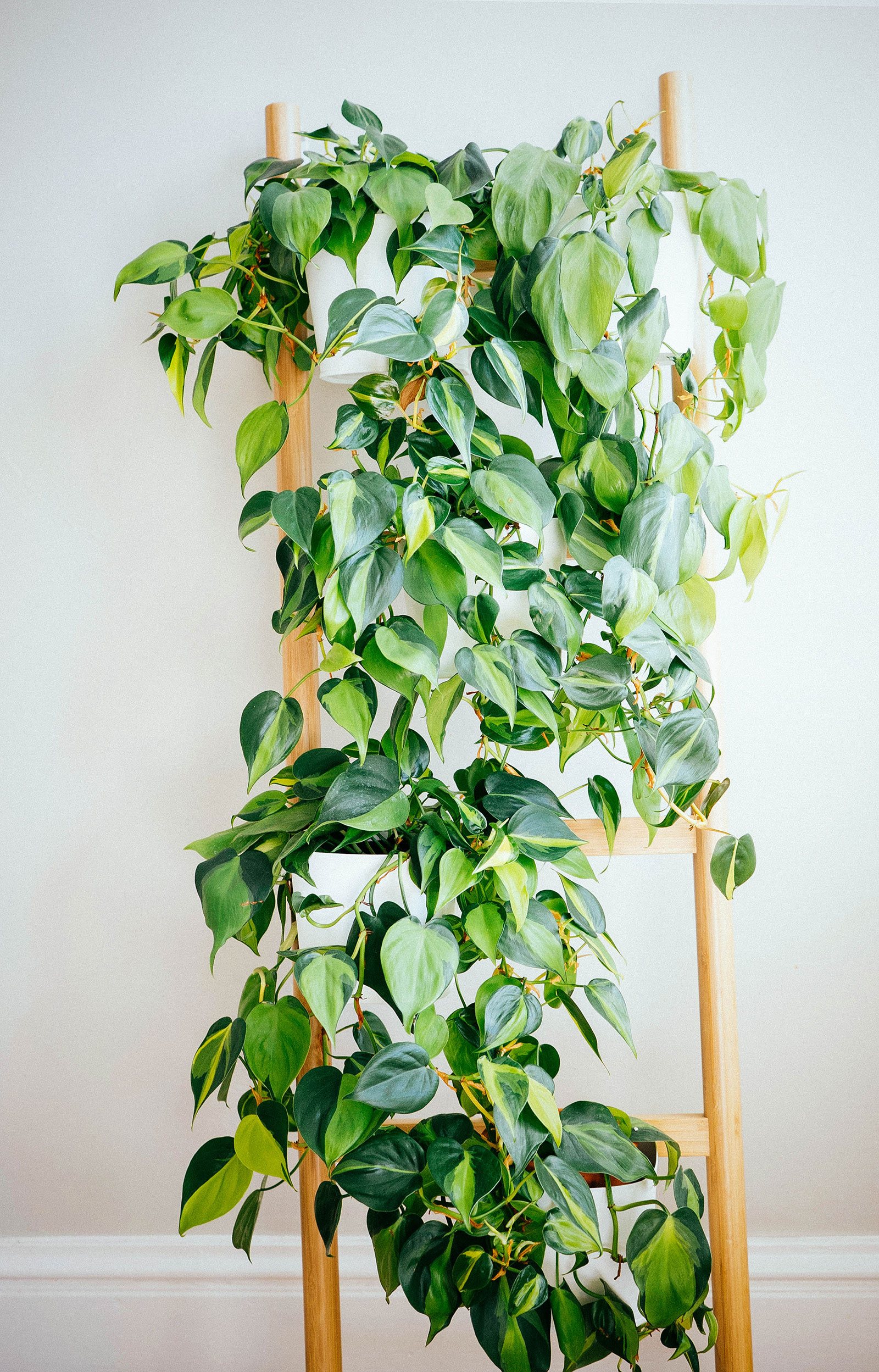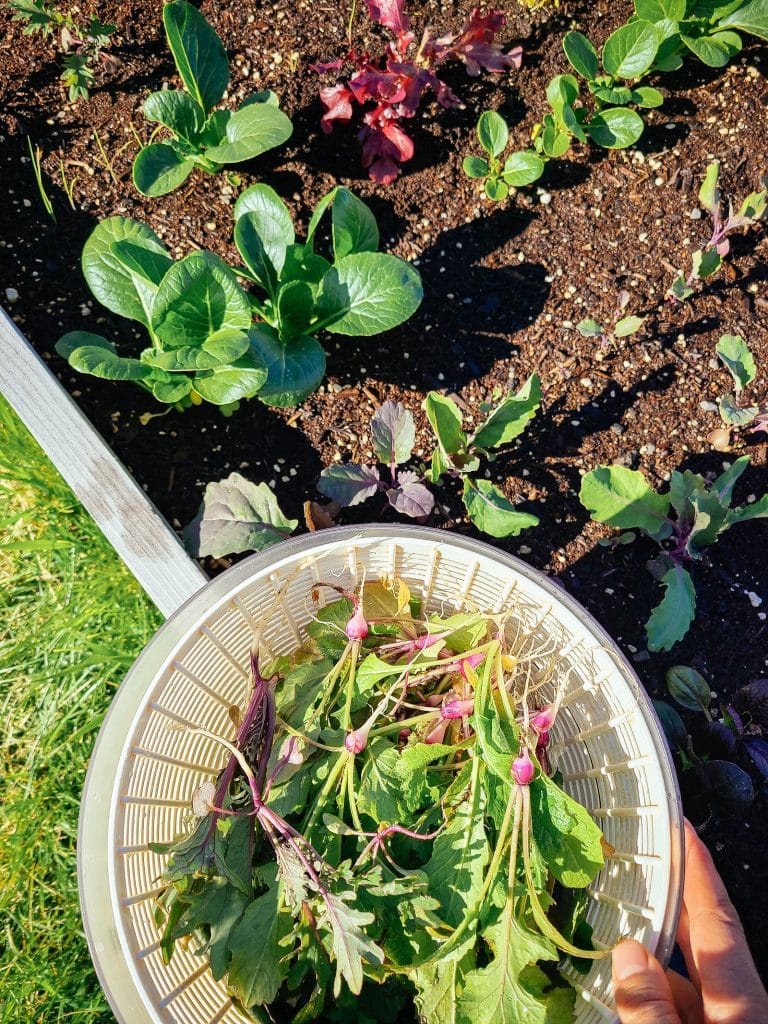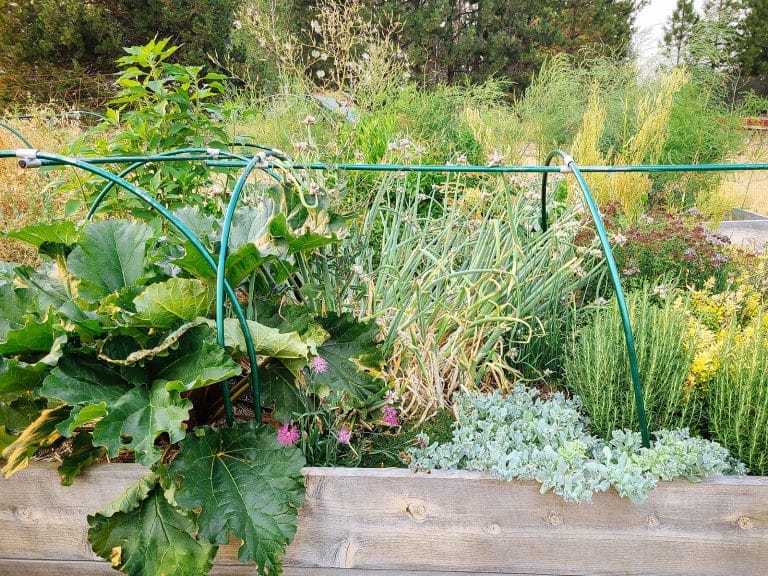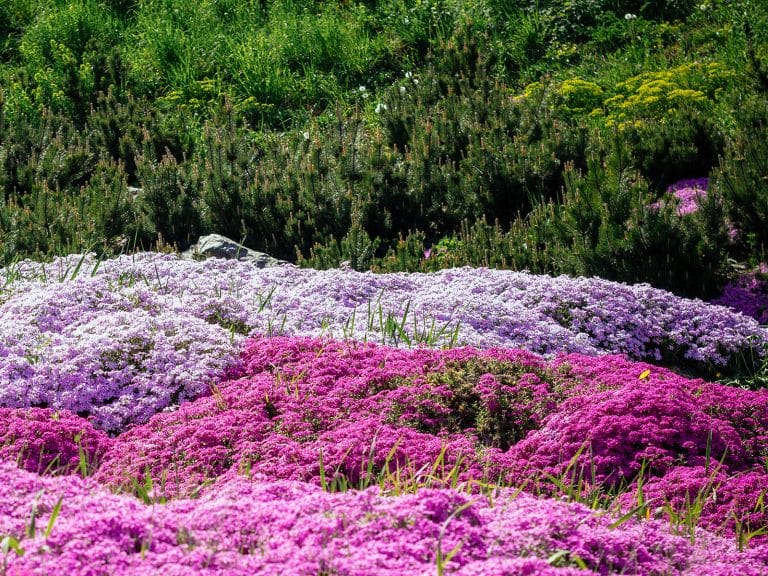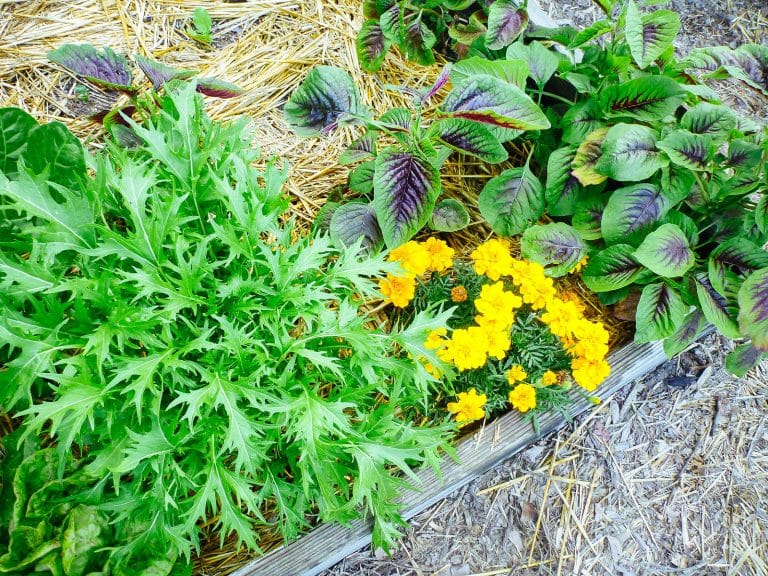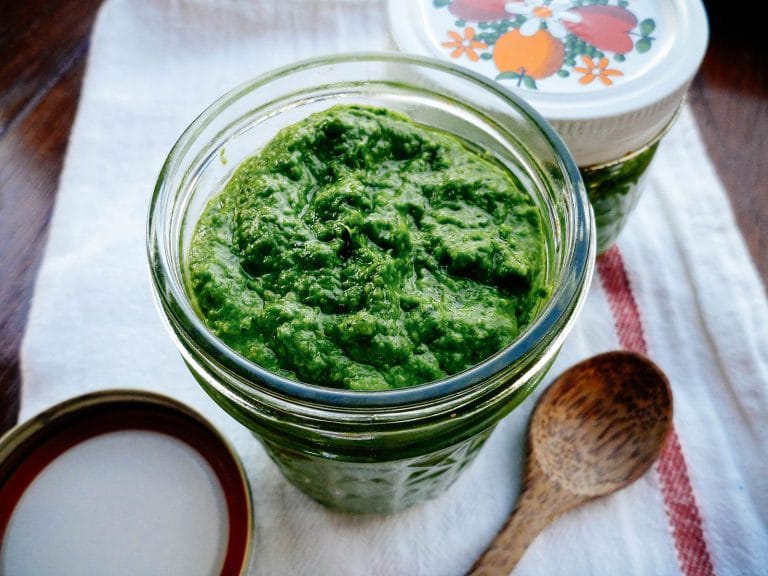If you’re looking for a nice new houseplant to spruce up your home, chances are you’ll come across the genus Philodendron. Some of the most popular indoor plants are Philos, including some truly wild-looking species and colorful variegated cultivars.
To help you make sense of what’s on offer, I’ve compiled a list of some of the most beloved Philodendrons in the houseplant world.
There’s no way we can discuss them all—I’d need to write a whole book to do that!—but you’re bound to find one you like here!
Disclosure: If you shop from my article or make a purchase through one of my links, I may receive commissions on some of the products I recommend.
What is a Philodendron?
If you’re a long-time houseplant collector, you probably already know exactly what a Philodendron is. Part of the aroid family, Araceae, this genus of plants is originally found in Central and South America.
There are almost 500 different types of Philodendrons, many of which you’ll recognize as being classic houseplant favorites. Even if you haven’t grown one yourself, you’ve probably seen them at someone’s house or in public spaces like stores and offices.
In the wild, Philodendrons tend to grow in rainforests. Most are (semi-)epiphytes, meaning they grow on the trunks of larger trees. They have aerial roots that allow them to clamp tightly (though non-parasitically) onto their hosts, using the support to quickly climb upwards in search of light.
This climbing habit is similar to other epiphytes (and fellow aroids), including many types of Alocasias (such as Alocasia zebrina, Alocasia ‘Polly’, and Alocasia ‘Black Velvet’) and Monsteras (such as Monstera siltepecana, Monstera deliciosa variegata, and Monstera Thai Constellation)
So let’s have a look at some of the many different Philodendron varieties that you may come across at your local plant shop. Some are proper species, while others are man-made cultivars or hybrids created through selective cultivation and/or crossing different species.
Read more: What Are Cultivars, Varieties, Hybrids and More: Layman’s Guide to Plant Taxonomy
Where to buy Philodendron plants:
Philodendron species
Sometimes, you don’t have to change anything about a plant. Some of the most popular Philodendrons that are sold “pure” (that is, not crossed or selectively bred) are the following:
Black gold Philodendron (Philodendron melanochrysum)

A beautiful vining Philo with large, dramatic leaves, the black gold Philodendron is one of the classics. It just has so much going on: matte, velvety foliage, leaves that come out orange and gradually darken to very dark green, and prominent light green leaf veins.
Philodendron melanochrysum naturally occurs in the Andean foothills of Colombia and is popular in its original form, but it does have to be said that it’s also favored by hybridizers. We’ll discuss a few varieties that have it in their parentage later!
If you’d like to know more, be sure to check out my full black gold Philodendron care guide.
Philodendron Brandi (Philodendron brandtianum)
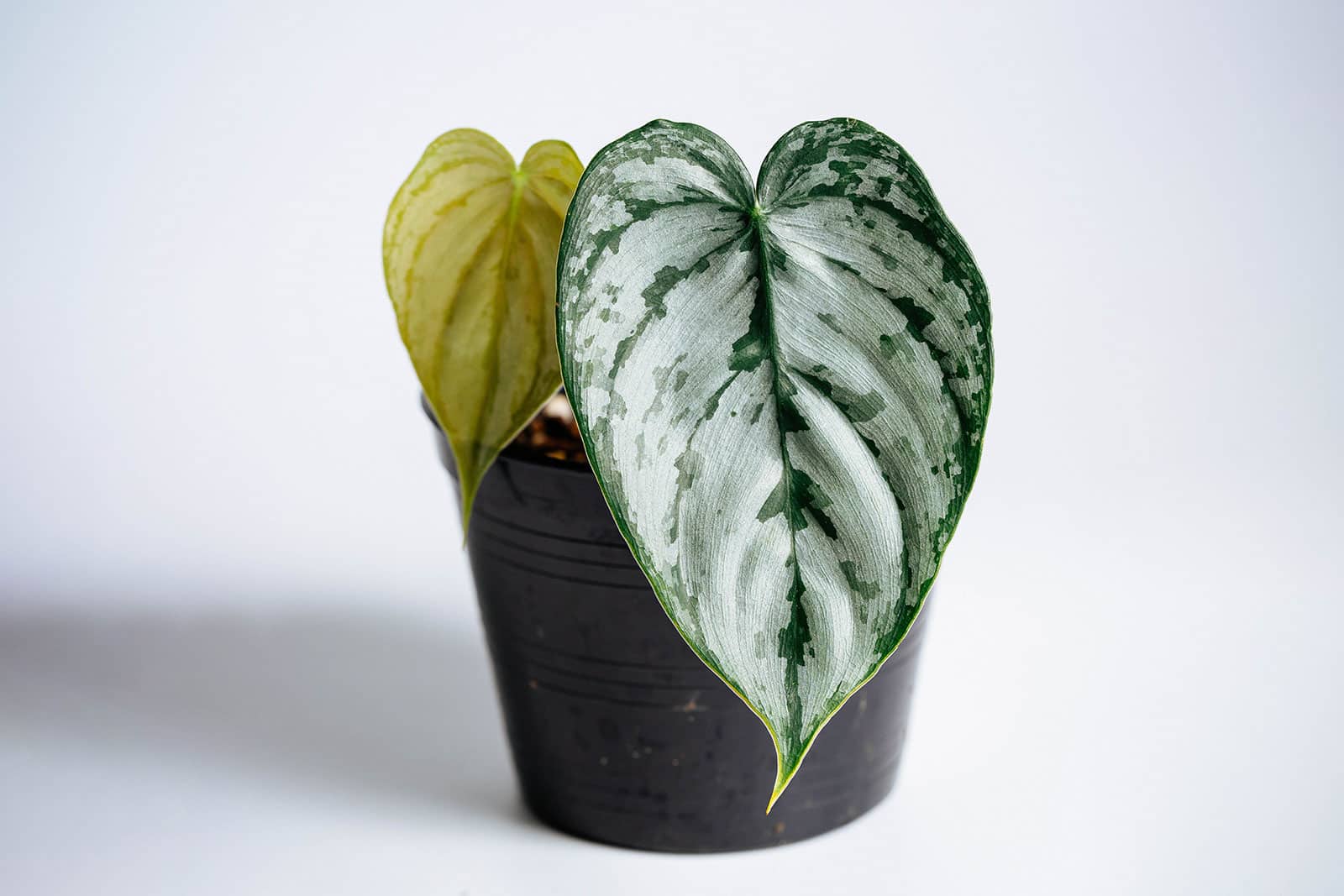
Another very striking “original” Philodendron species is the silver leaf Philo, scientifically known as Philodendron brandtianum but also sometimes referred to as “Brandi”.
With the beautiful silver mottling on this species’ leaves you’d almost believe it’s a man-made cultivar, but nope, it’s all natural.
Philodendrons are known for the sometimes dramatic differences in looks between young and mature plants. Brandi is a good example of this: Its immature foliage is small and heart-shaped, but it can actually produce humongous leaves once it’s had some time to grow up!
If you want to grow your own XL Philodendron brandtianum, don’t forget to check out the tips in my full silver leaf Philo care guide.
Philodendron gloriosum
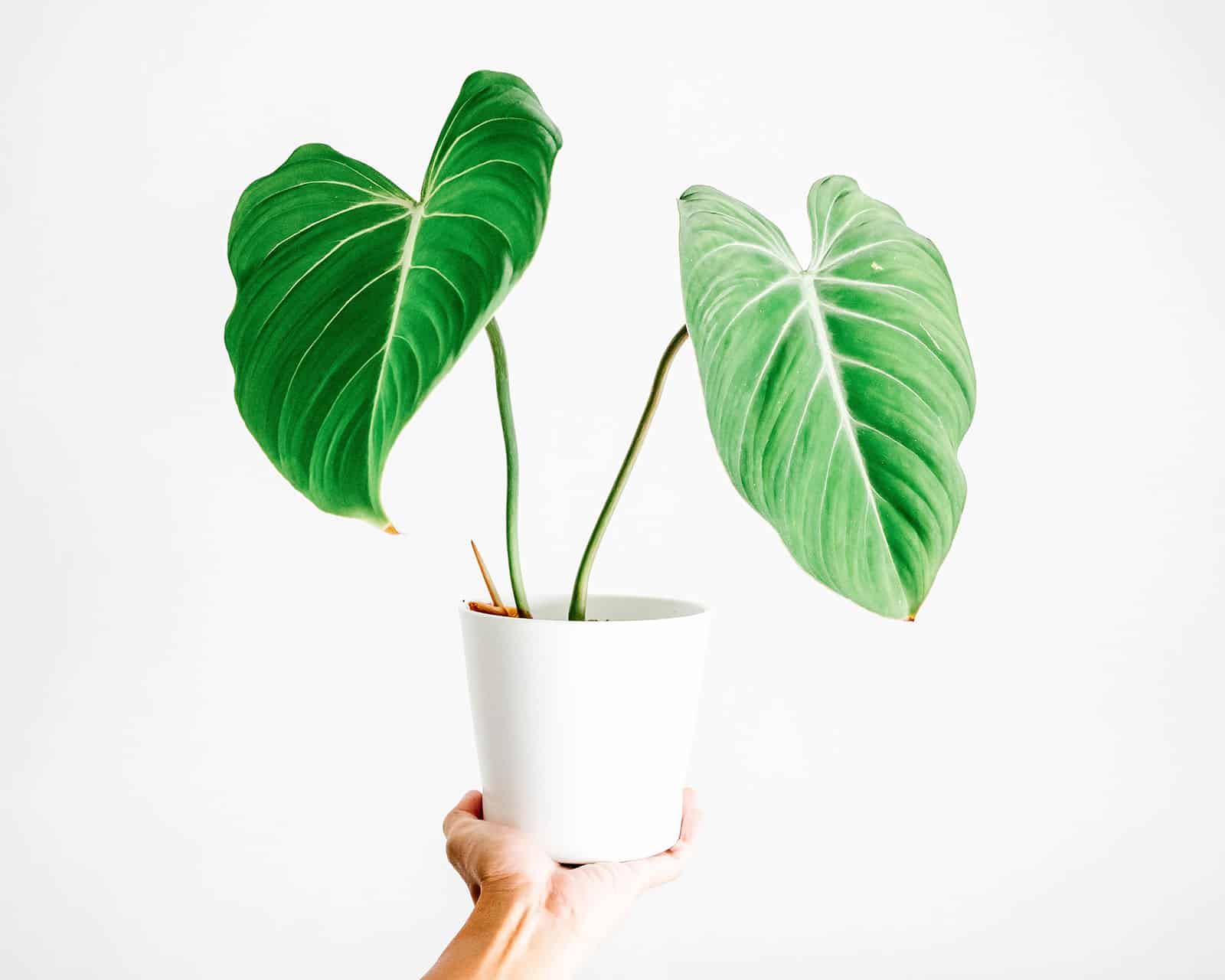
Another Philo that’s often sold in its original state but also frequently used in hybridization efforts, Philodendron gloriosum is widely admired for its big, heart-shaped leaves. As with P. melanochrysum, the foliage is velvety, dark green and matte, with much lighter leaf veining for extra dramatic effect.
Like a whole bunch of other Philodendrons, this one is naturally found in the jungles of Colombia. As discussed in my full Philodendron gloriosum care guide (along with everything else you need to know about its growth habits and propagation methods), it’s unusual in its genus in that it’s a creeping rather than a climbing plant.
Philodendron rugosum
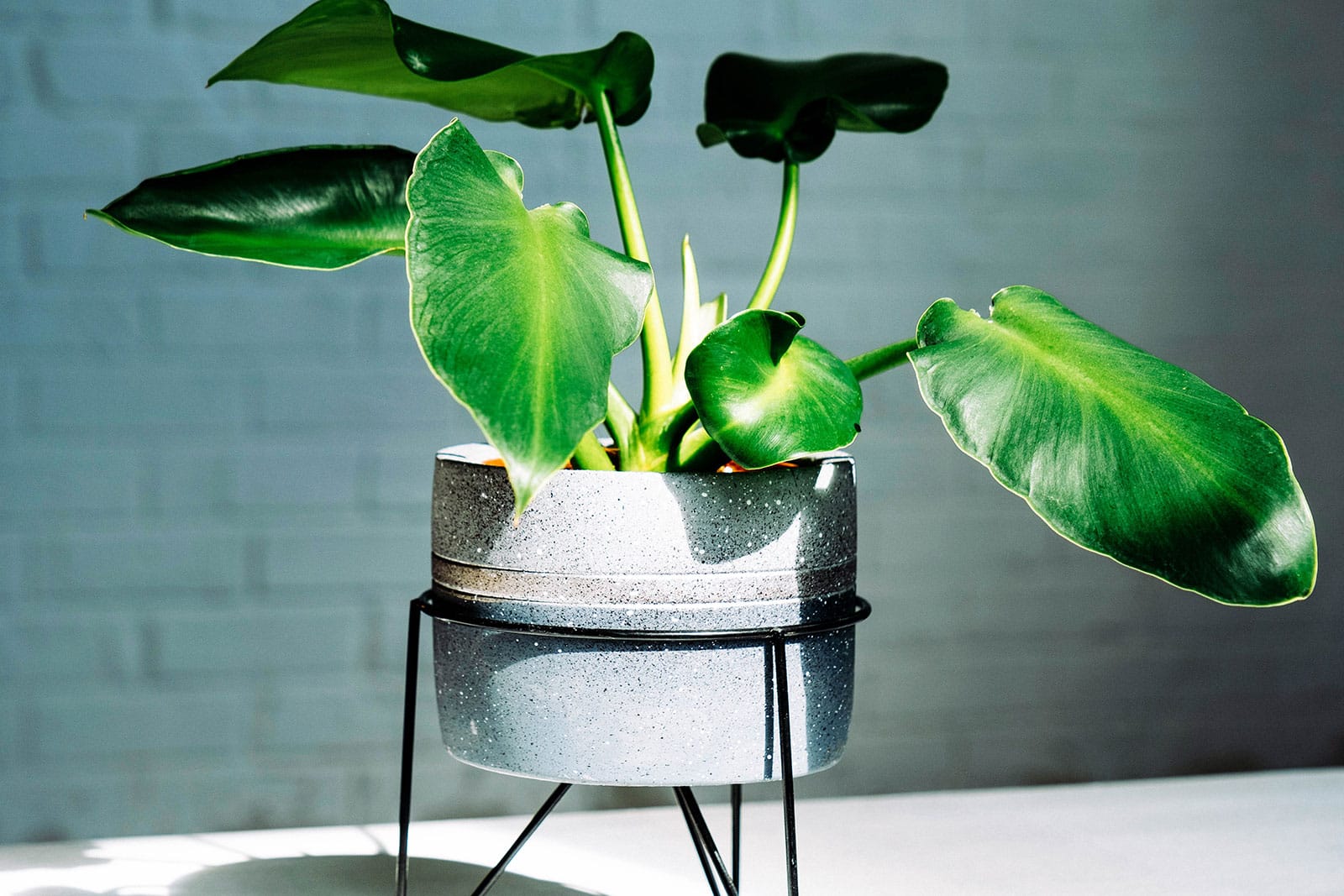
Also (not very flatteringly) known as the pigskin Philodendron, this one is well-coveted but not very common in the houseplant scene. It can be recognized by its thick, almost plastic-looking and slightly wrinkly leaves, which have thin but noticeable white margins.
Philodendron rugosum is naturally found in rainforests and southern Colombia and Ecuador, where it’s unfortunately noted to be Near Threatened by the IUCN. It’s considered pretty lucky to find one for sale!
Philodendron verrucosum
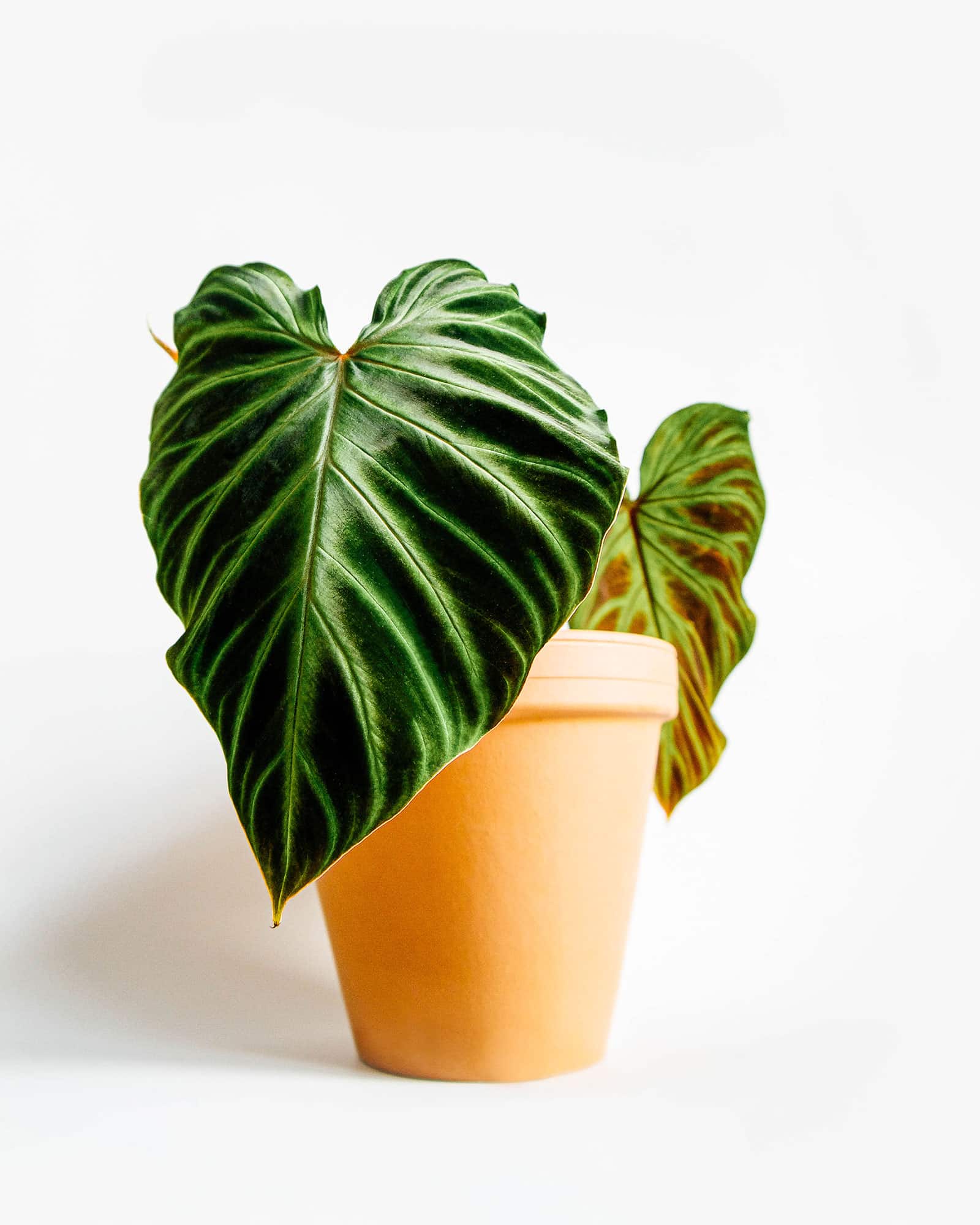
How cool are the leaves on this one? Philodendron verrucosum is another velvety Philo species with heart-shaped foliage. The difference is in the leaf veins, which are neon green and fork dramatically near the edges of the leaves.
Naturally found between Costa Rica and Peru, this species isn’t considered the easiest Philodendron to care for. Like some of the other species in the genus, it’s better for more experienced houseplant growers, as it’s particularly fussy about humidity.
Philodendron billietiae

The long, wavy-edged leaves on Philodendron billietiae make this relatively uncommon plant a real eye-catcher.
This especially applies to mature specimens, whose leaves can reach almost 2 feet in length! Talk about bringing the jungle into your home.
This species occurs in Brazil, French Guiana, and Guyana, where (like most other Philodendrons) it inhabits jungle habitats. It’s a relatively recent addition to the houseplant hobby, which isn’t surprising considering the fact that it wasn’t discovered and officially described until 1995.
By the way, if you like this one, you may also appreciate Philodendron atabapoense, which has similar-looking leaves. In fact, crosses between the two exist!
Philodendron burle-marxii
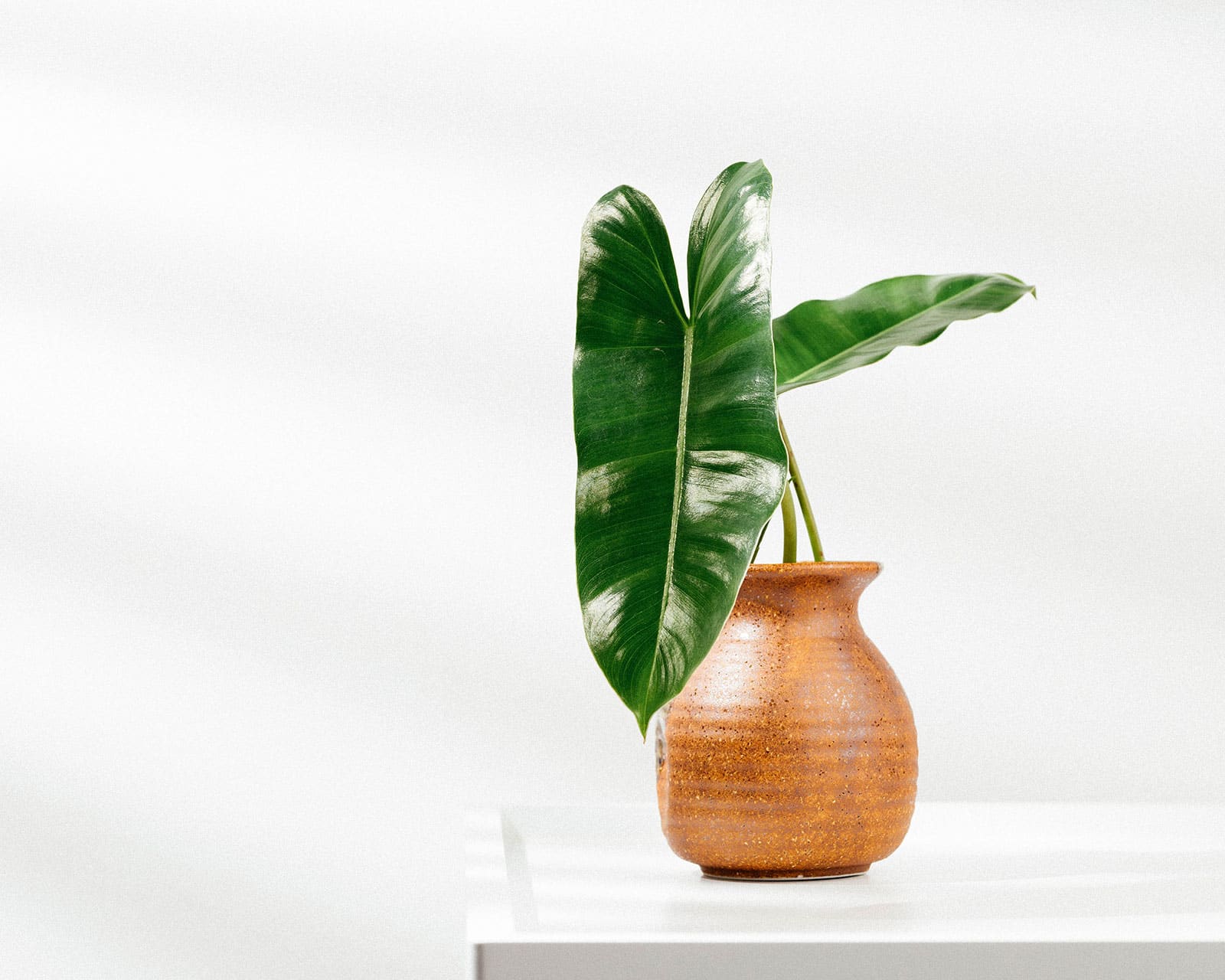
Hope you’re wearing sunglasses, because this Philodendron is SHINY! If you love a good foliage plant, P. burle-marxii might just be the one for you. It has glossy, elongated leaves in a gorgeous shade of emerald green.
Found in Ecuador, Colombia, and Northern Brazil, this species was named after a famous landscaping architect from Brazil, who became renowned in part for his use of plants from his native country in his designs.
Those who prefer a variegated plant are in luck: marbled varieties of Philodendron burle-marxii do exist. They’re a bit pricey, though.
Philodendron squamiferum
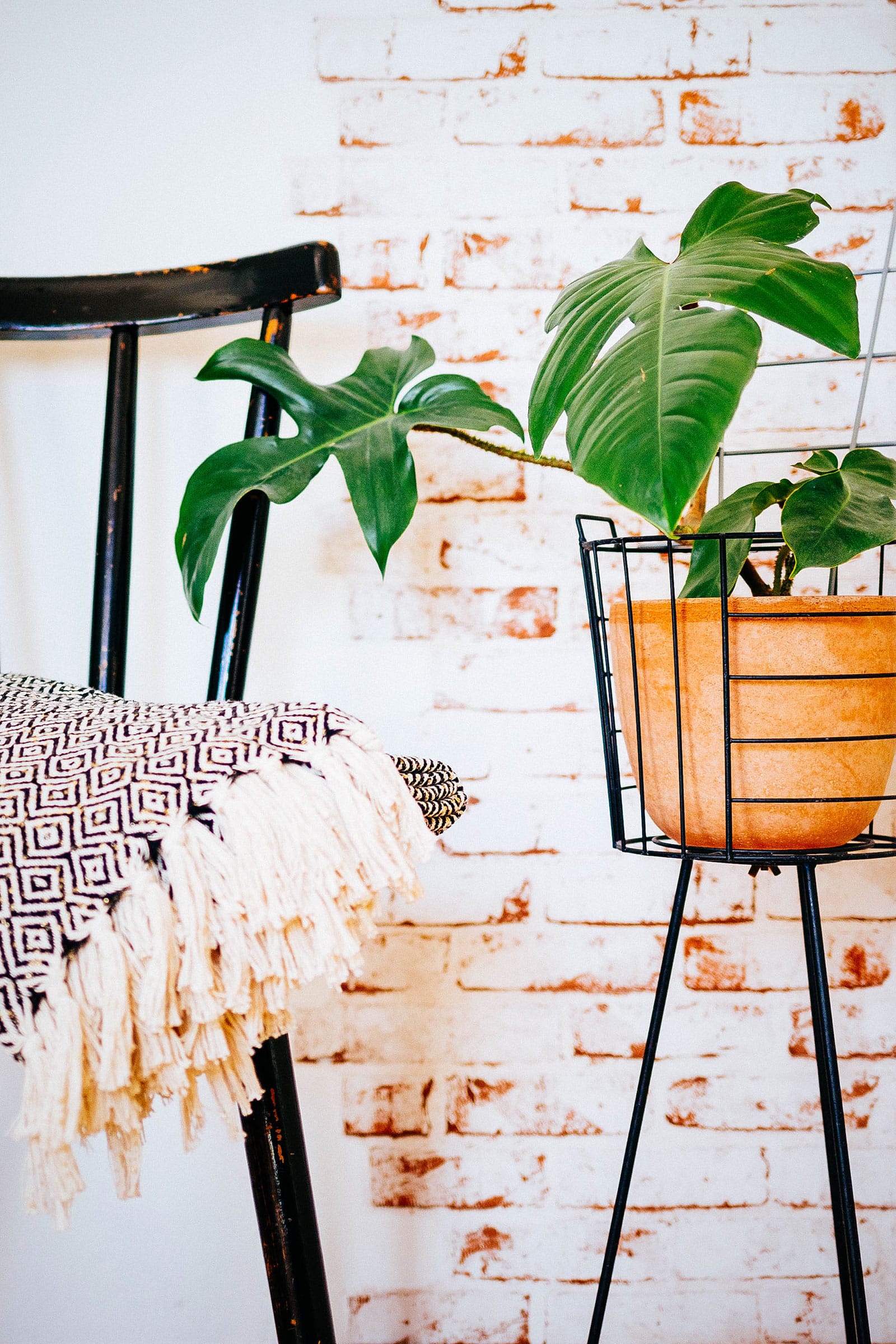
I love a good oddball plant, and that’s definitely what this one is. The first thing you’ll notice about Philodendron squamiferum is its head of pretty, lobed leaves.
After that, though, your eyes will go straight to its strangely hairy-looking stems, which are covered in light green to reddish bristles! (No wonder it’s sometimes called the Hairy Philodendron.)
This species hails from Brazil, Suriname, and French Guiana. It’s not the most popular Philodendron in the houseplant trade, but it’s not too difficult to find in specialized plant stores either, nor is it wildly expensive. Its easy care makes it a great choice for beginning Philodendron collectors.
Philodendron spiritus-sancti
When it comes to wild foliage, it doesn’t get much better than the “Holy Spirit” Philodendron, scientifically known as P. spiritus-sancti. Those extremely elongated, huge leaves truly make this one of the craziest-looking Philos out there.
Unfortunately, of course, this amazing plant also happens to be rare. Its natural range, in the province of Espirito Santo in Brazil, is very small; it’s not very common in horticulture at all. As a result, you can expect to pay a minimum of a couple hundred dollars for one.
When buying rare Philodendrons (and other houseplants, particularly other aroids), it’s important to make sure they have been ethically sourced. Houseplant enthusiasts being willing to pay hundreds of dollars for a plant has led to poaching becoming a significant threat for some species, including this one.
Philodendron camposportoanum
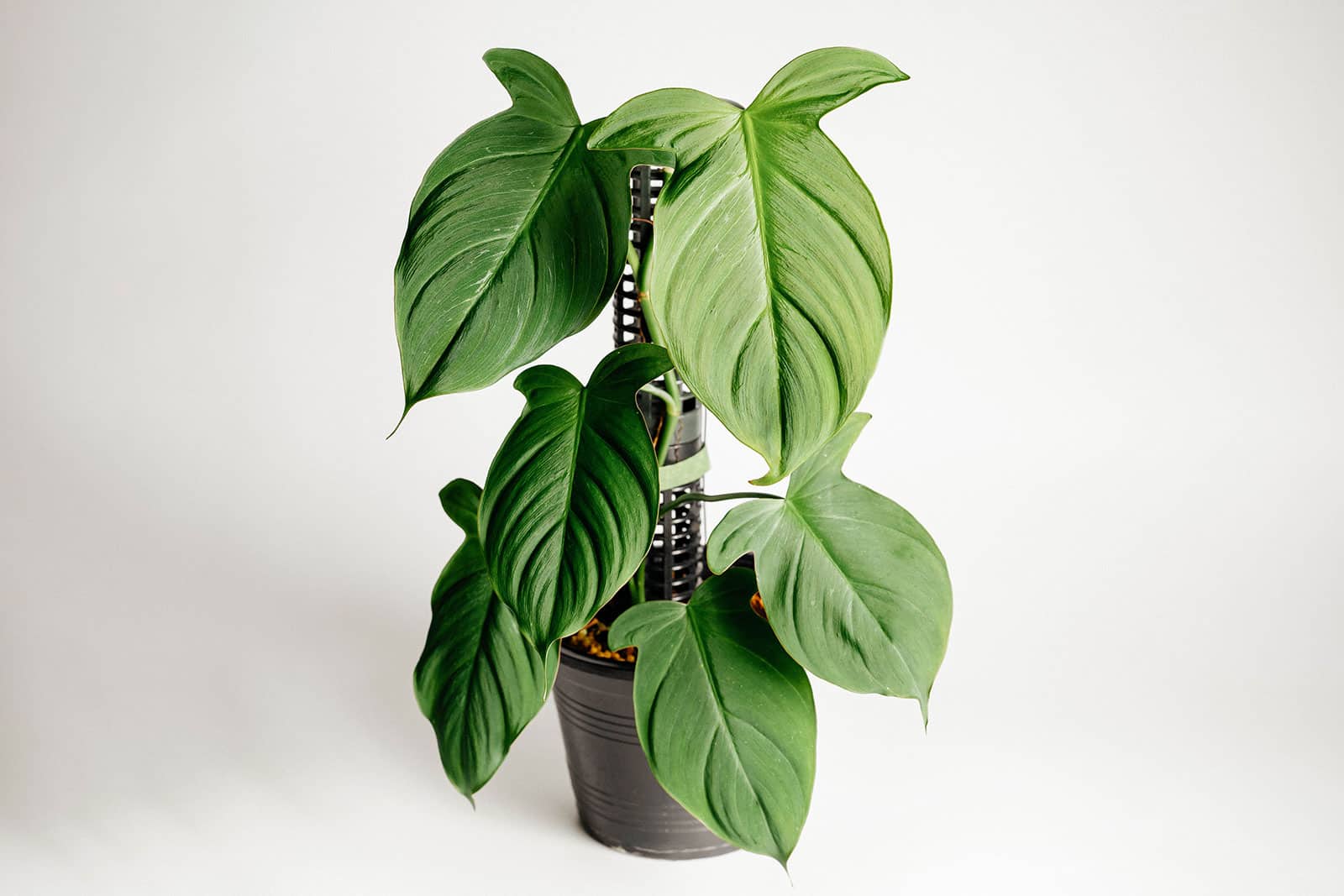
If you’re familiar with the more common vining Philodendron hederaceum ‘Micans’, you might think you’re seeing double if you’re presented with a Philodendron camposportoanum. But nope, they really are two different plants!
Although both juvenile P. camposportoanum plants and ‘Micans’ have heart-shaped, velvety foliage in shades of reddish-green, the former changes as it matures. The leaves will be larger and more arrowhead-shaped, with the lobes becoming more pronounced as the plant ages and is allowed to climb.
Naturally found from Mexico all the way down from Bolivia, this Philodendron is now relatively easy to find in houseplant stores. It’s known for being easy-care and beginner-proof.
Philodendron giganteum
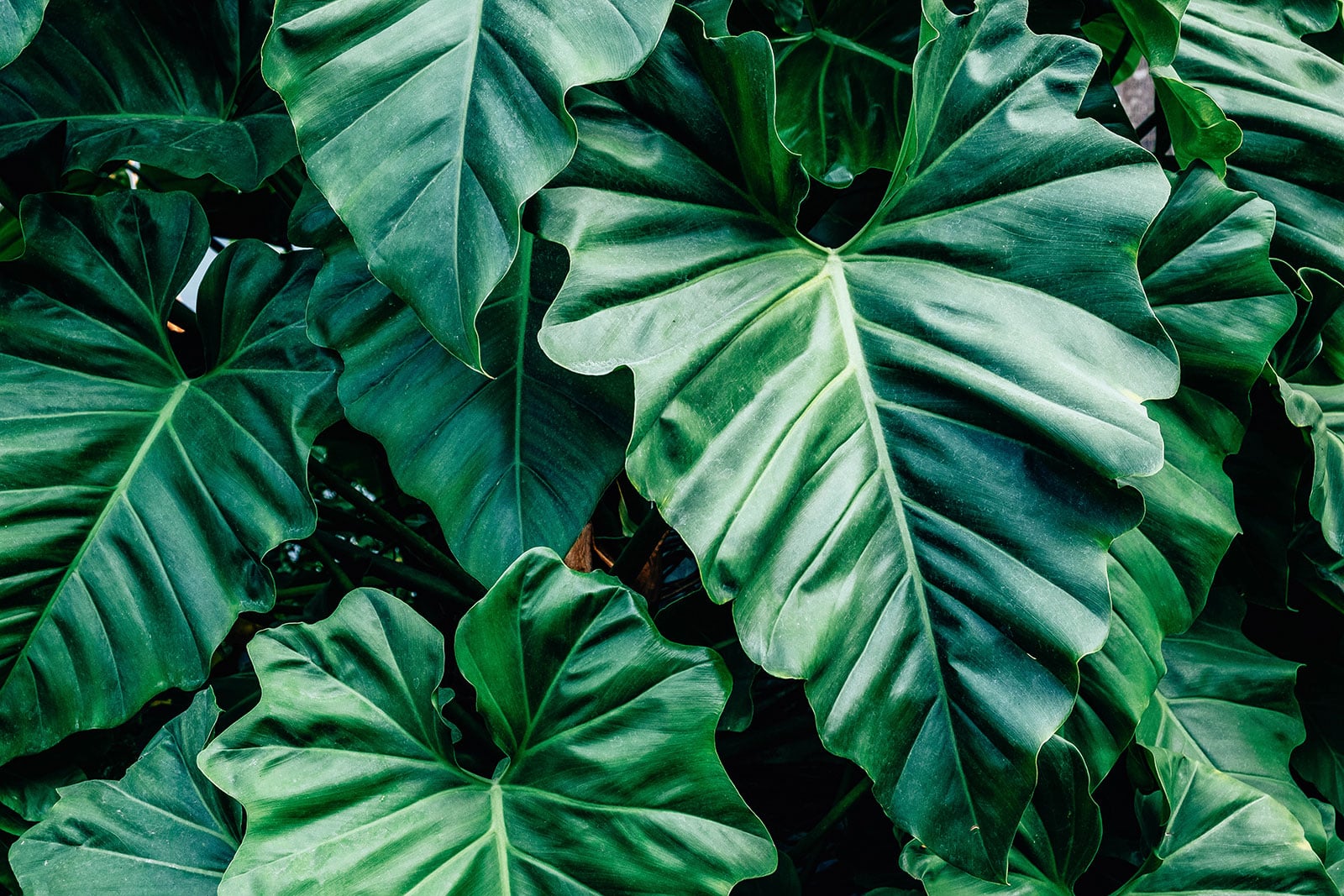
When it comes to houseplants, the bigger the better, am I right? If your home is still missing an eye-catching centerpiece, the appropriately named Philodendron giganteum might be just what you’re looking for.
With leaves that can reach up to 3 feet across, the giant Philodendron is almost reminiscent of the similarly humongous Alocasia odora from Asia, another popular XL houseplant. The difference is that it’s still a Philo, meaning it likes to climb and will need a nice and sturdy support as it matures.
For those who prefer a variegated plant, a marbled Philodendron giganteum variety does exist. It’s a little on the expensive side, but it’ll look stunning once it reaches its full size potential!
Philodendron mayoi
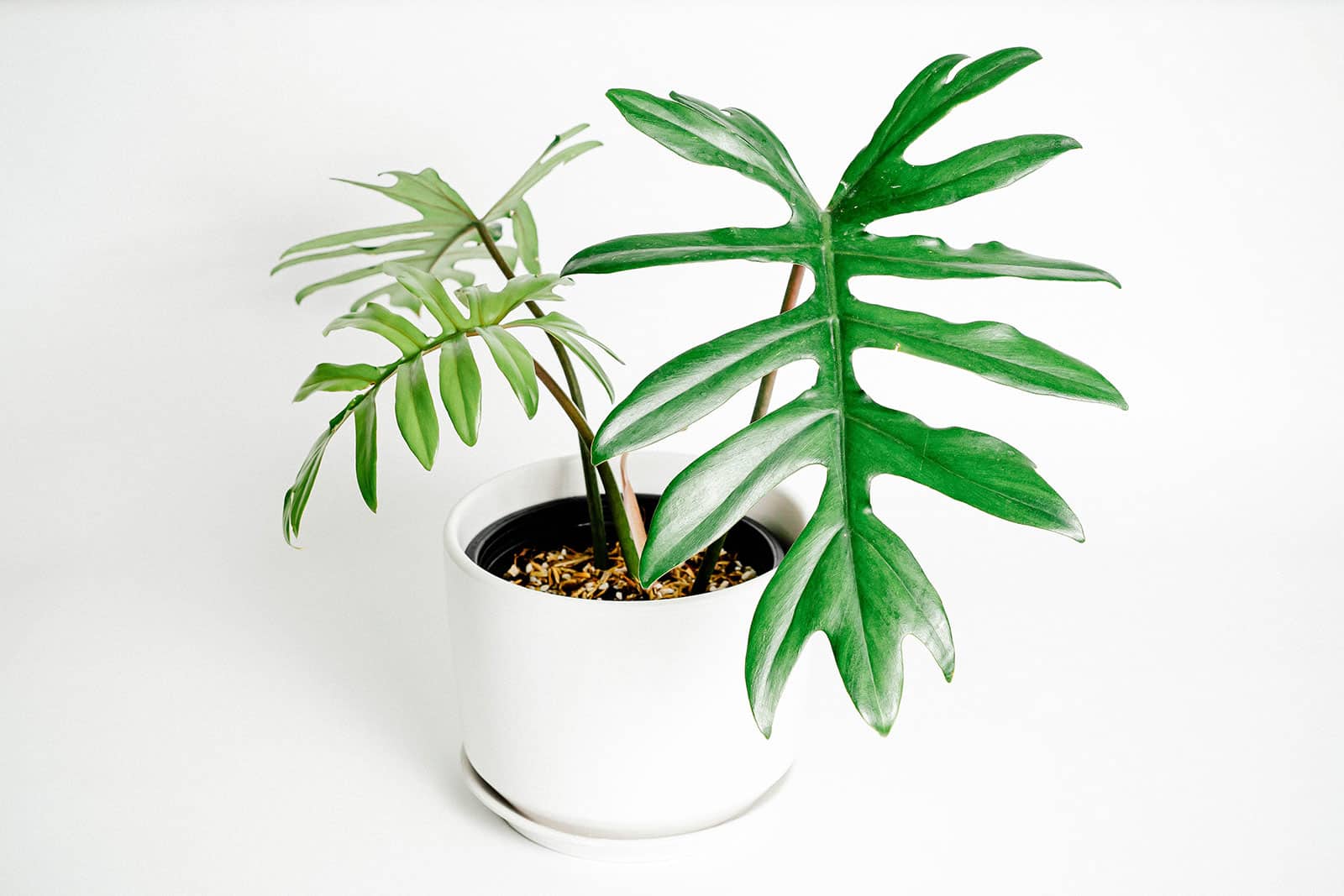
A relatively new addition to the houseplant hobby, Philodendron mayoi was first described in 2000. It naturally occurs in Brazil, where it grows both on trees or rocks and as a creeping plant across the forest floor.
Although it’s not a very common houseplant yet, Philodendron collectors love this species for its pretty lobed leaves, which are almost palm- or fern-like. P. mayoi looks quite similar to some plants of the genus Thaumatophyllum, but can be told apart by its often reddish petioles.
Bamboo Nurseries Philodendron cultivars
If you’re going to talk about Philodendrons varieties, it’s impossible not to bring up Bamboo Nurseries outside of Orlando, Florida, so let’s start with that.
This nursery was owned by Robert McColley and his wife Cora, and it was the site of extensive hybridization and selective breeding with different Philodendron species.
As stated by Bob in one of his articles:
“It seems nature provided only two types of foliage plants, those that are tough but of little beauty and those that are beautiful but soft and susceptible to ills from climate and diseases.”
His solution to this was crossing the different species in order to get the best of both worlds. He began doing just that in 1951.
The McColleys’ nursery produced a whole bunch of the most well-known Philo cultivars we still know and love today, both before and after Robert’s sudden passing in 1977. Cora took over the nursery at this point, working with Dr. Howard N. Miller to continue the hybridization program.
Although the program itself was pretty much discontinued after Miller retired a few years later, Cora didn’t give up on the plants, continuing to raise them at the nursery. She regularly found new and interesting color varieties among the seedlings, patenting and naming them for commercial purposes until her eventual retirement.
Did you know? With the exception of P. ‘Florida’, the McColley Philodendron varieties discussed here are self-heading. This refers to Philos that have a shorter stem and more compact, rosette-like growth pattern.
Let’s have a look at some of the McColleys’ work:
Philodendron ‘Florida’
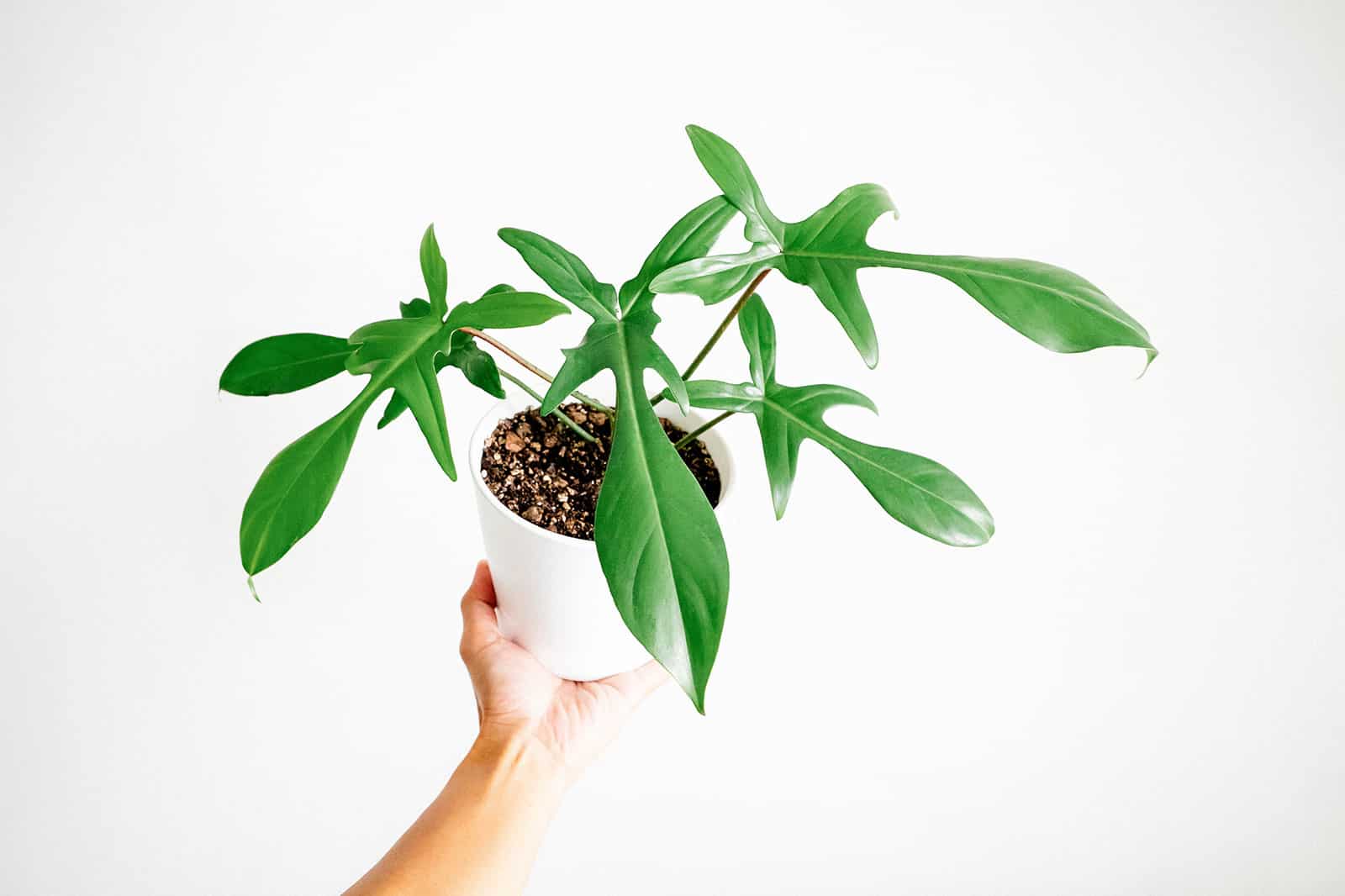
One of the earliest (and still most well-known) plants attributed to Bob McColley is Philodendron ‘Florida’, a cross between P. squamiferum and P. pedatum. He actually describes the process in a 1965 article for the Florida State Horticultural Society.
Back then, the business of creating houseplant hybrids was still in its infancy, and McColley notes running into issues like having to figure out how to cross a spring-blooming and an autumn-blooming plant.
Anyway, he managed, and Philodendron ‘Florida’ (now sometimes called ‘Florida Green’ to set it apart from subsequent cultivars like the pale ‘Florida Ghost’) was born.
Characterized by its climbing habit and beautiful foliage, the ‘Florida’ range now also includes a variegated form called ‘Florida Beauty’.
Philodendron ‘Painted Lady’
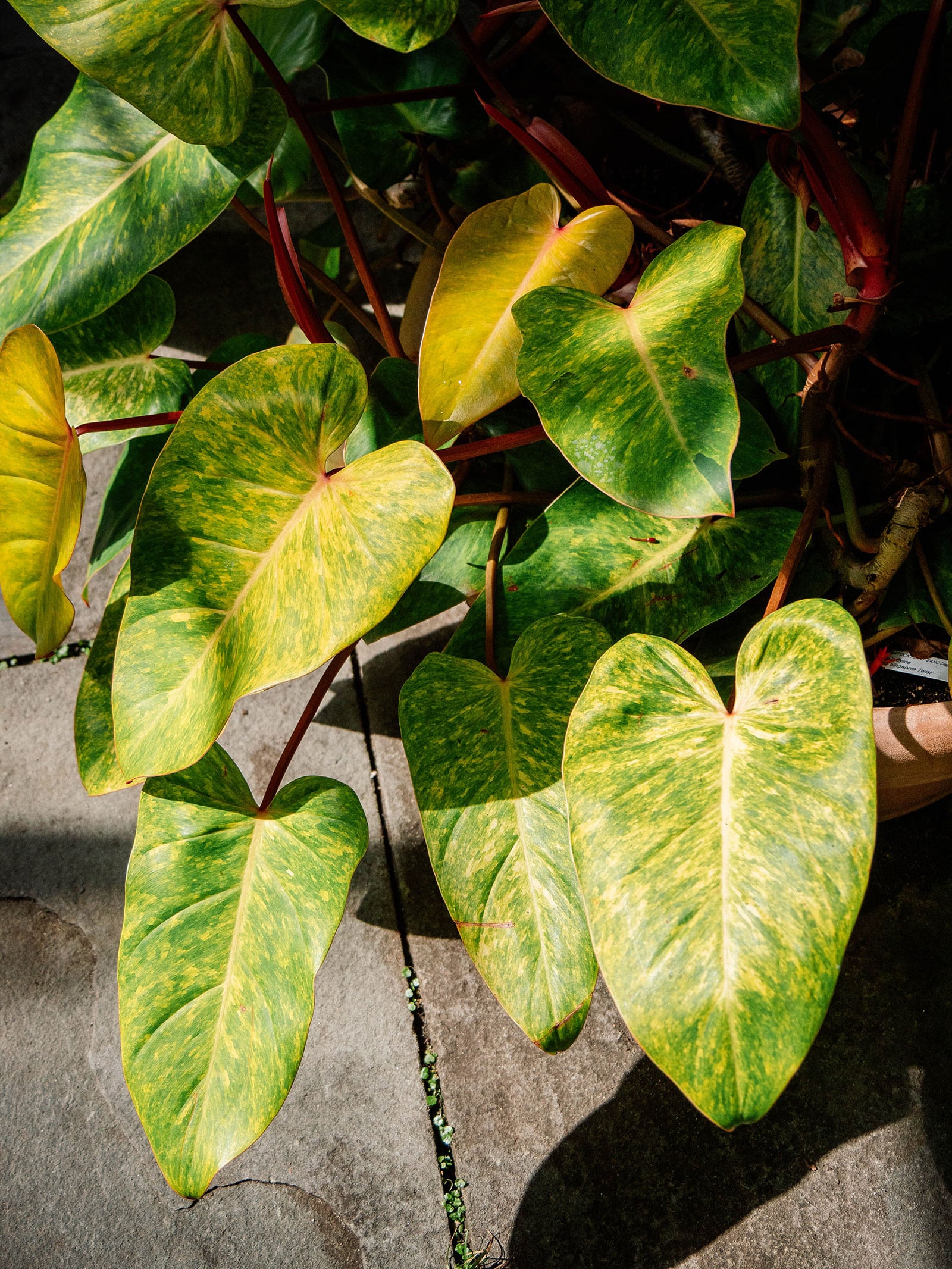
Another one of Robert McColley’s creations is Philodendron ‘Painted Lady’, which is easy to recognize by the gorgeous yellow mottling on its bright leaves. Newer leaves are more yellow in color and darken to green as they mature, although most never entirely lose their patterns.
As an added bonus, the stems on this cultivar are a pretty reddish pink in color
Although its actual name isn’t mentioned in the patent (with number USPP3958P), given the description, there’s little doubt that the plant registered in 1976 by McColley is ‘Painted Lady’:
“There is here disclosed a Philodendron plant particularly characterized by the yellow and green mottling of the newer leaves, the leaves as they mature ultimately reaching a state where they appear to be of two shades of green, bright red stems and petioles being further notable identifying aspects of the plant.”
The parent plants for this variety are listed as two other man-made cultivars: Philodendron ‘Burgundy’ and P. ‘Emerald Queen’. The former was also developed by Robert.
Philodendron ‘Black Cardinal’
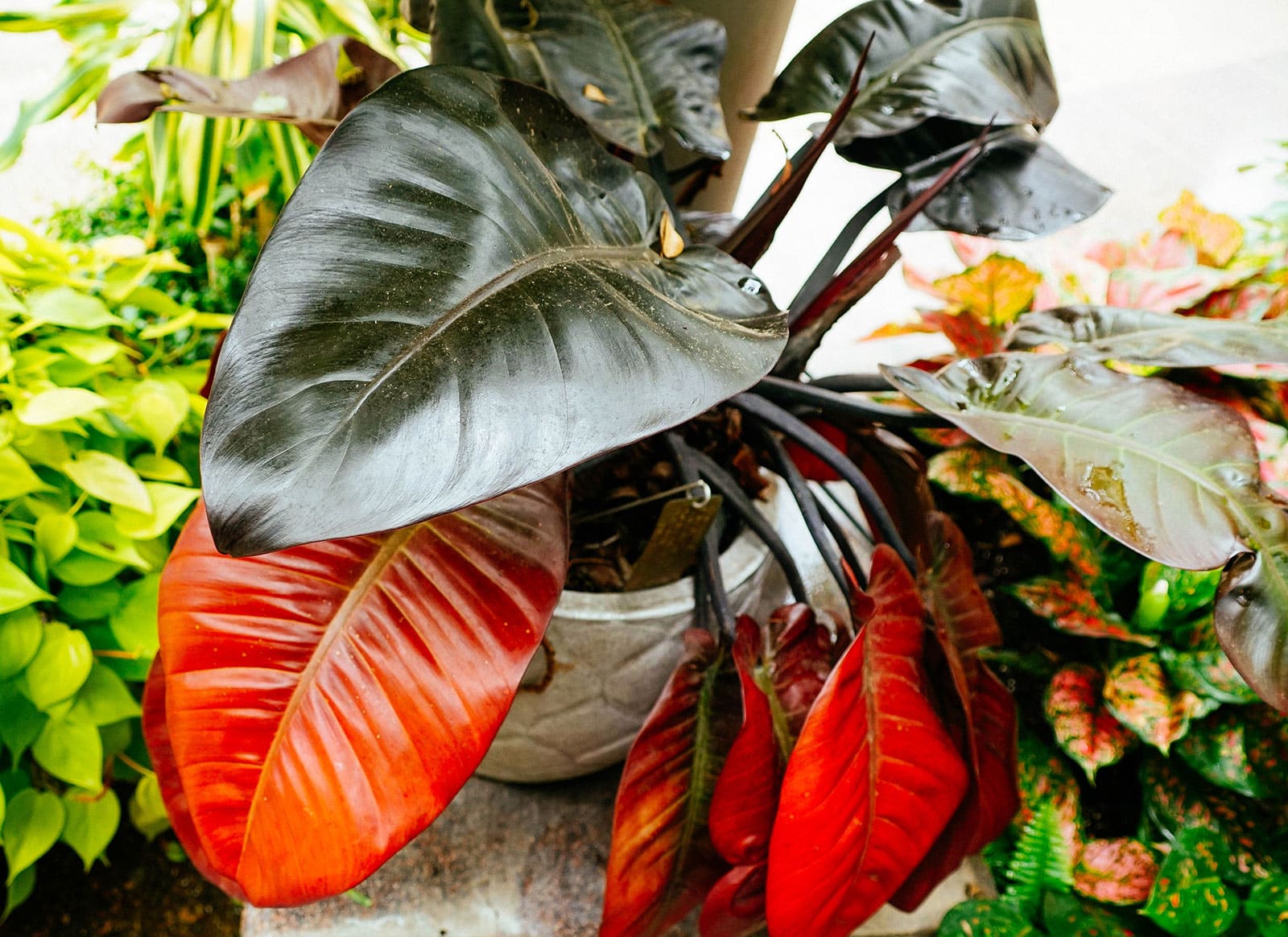
If you’ve got a penchant for the dramatic (and when it comes to houseplants, let’s be honest, who doesn’t?), you’ll love the gothic-looking Philodendron ‘Black Cardinal’ and its shiny, reddish-black foliage.
Patented by Cora McColley in 1983 (expired 2003), ‘Black Cardinal’ is described as not just being very decorative, but also hardy. It doesn’t mind lower light conditions and is reasonably tolerant to drought, making it a suitable choice for beginning Philodendron lovers.
And there are even variegated versions, which have pale pinkish-orange splashes on their leathery black leaves!
Did you know? If can’t find Philodendron ‘Black Cardinal’, try ‘Royal Queen’. Even McColley admits in her patent application that it looks pretty similar. You can also go for the striking ‘Dark Lord’.
Philodendron ‘Prince of Orange’
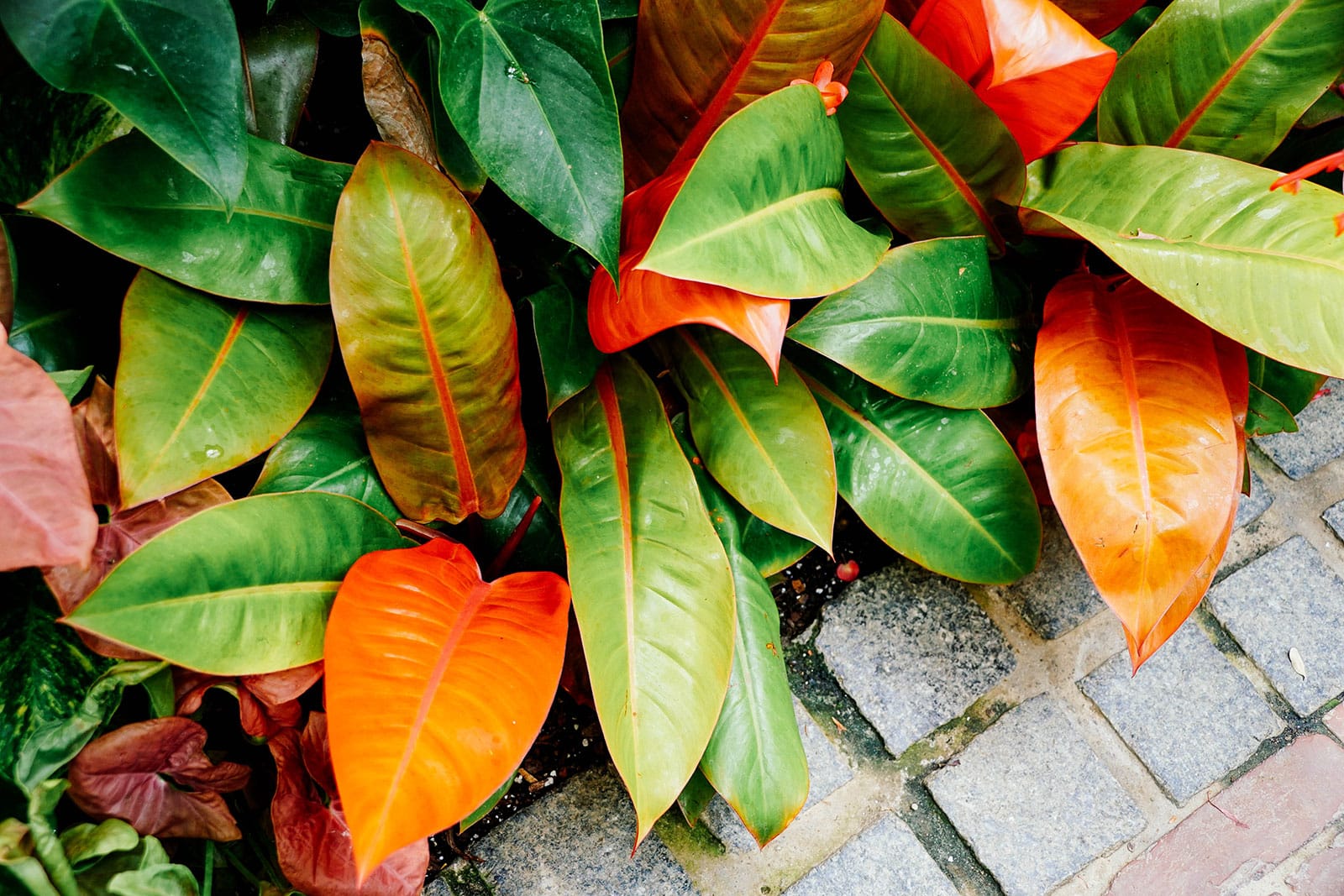
Patented by Cora McColley in 1988 (expired 2008), Philodendron ‘Prince of Orange’ has recently seen a bit of a resurgence in popularity. Not surprising, because it’s a very attractive and unique plant: large, glossy leaves come out bright orange and don’t darken into green until they’re fully mature.
Like most of the colorful Philodendron cultivars produced in the McColley nursery, ‘Prince of Orange’ has a whole bunch of different species in its parentage. This includes P. erubescens, but also P. domesticum, wendlandii, imbe, and cannifolium. Talk about a checkered past!
Philodendron ‘McColley’s Finale’
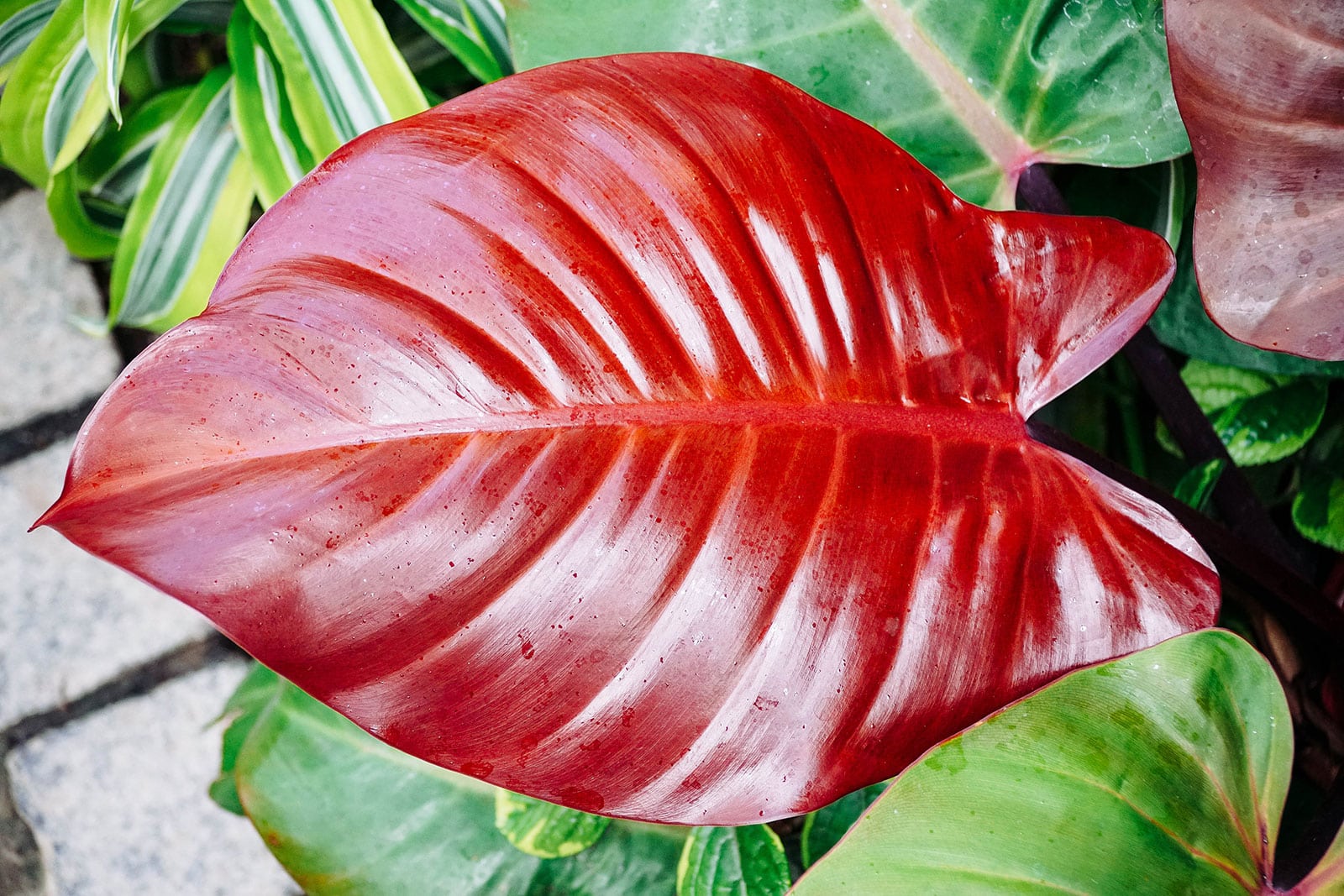
At first glance, you might think you’re seeing double when you spot Philodendron ‘McColley’s Finale’. Doesn’t it look suspiciously like ‘Prince of Orange’?! You wouldn’t be entirely wrong: the two cultivars are quite similar in terms of looks.
As mentioned in the patent, which was filed in 1999 and expired 20 years after that, the leaves on ‘McColley’s Finale’ emerge with a reddish hue rather than the bright orange of ‘Prince of Orange’. The former also features more pointy foliage.
This being said, their exact appearance depends on the environment they’re grown in, meaning that even long-time houseplant enthusiasts sometimes still mix them up.
Did you know? As the name suggests, ‘McColley’s Finale’ was discovered and named by Cora McColley, as a tribute to her late husband and his work.
Other Philodendron cultivars from Bamboo Nurseries
I’ve only discussed the McColleys’ most popular Philodendron cultivars, otherwise we’d be here all day. If you’re a fan of their work, also keep an eye out for:
- Philodendron ‘Prince Albert’
- Philodendron ‘Red Empress’
- Philodendron ‘Emerald Prince’
- Philodendron ‘Baron’
- Philodendron ‘Emerald Duke’
- Philodendron ‘King of Spades’
- Philodendron ‘Burgundy’
Blushing Philodendron (Philodendron erubescens) cultivars
Also known as the blushing or red Philodendron, P. erubescens is one of the species in the genus that has spawned a notable amount of cultivars. The McColleys used it extensively in their breeding program, for example.
Here are a few of the most popular non-hybrid Philodendron erubescens cultivars (most of the others are mixed with a bunch of additional plants):
Philodendron ‘Pink Princess’

Let’s kick off the list with one of the most stunning Philodendron varieties available (so far): the appropriately named ‘Pink Princess’. With hot pink splashes on its reddish-green foliage, it’s not surprising this cultivar has recently surged in popularity!
Philodendron ‘Pink Princess’ is one of many unpatented Philo varieties, so it isn’t entirely clear who created it.
As I mentioned in my ‘Pink Princess’ plant care guide, some folks think it might have popped up in the McColleys’ nursery. Given they normally patented their plants, though, it seems odd that they wouldn’t have done so in this case.
On the other hand, the Princess might just be a spontaneous mutation in Philodendron erubescens. However it came to be, I know it’s one of my personal favorites, especially now that it has become more affordable and widely available.
Philodendron ‘White Princess’
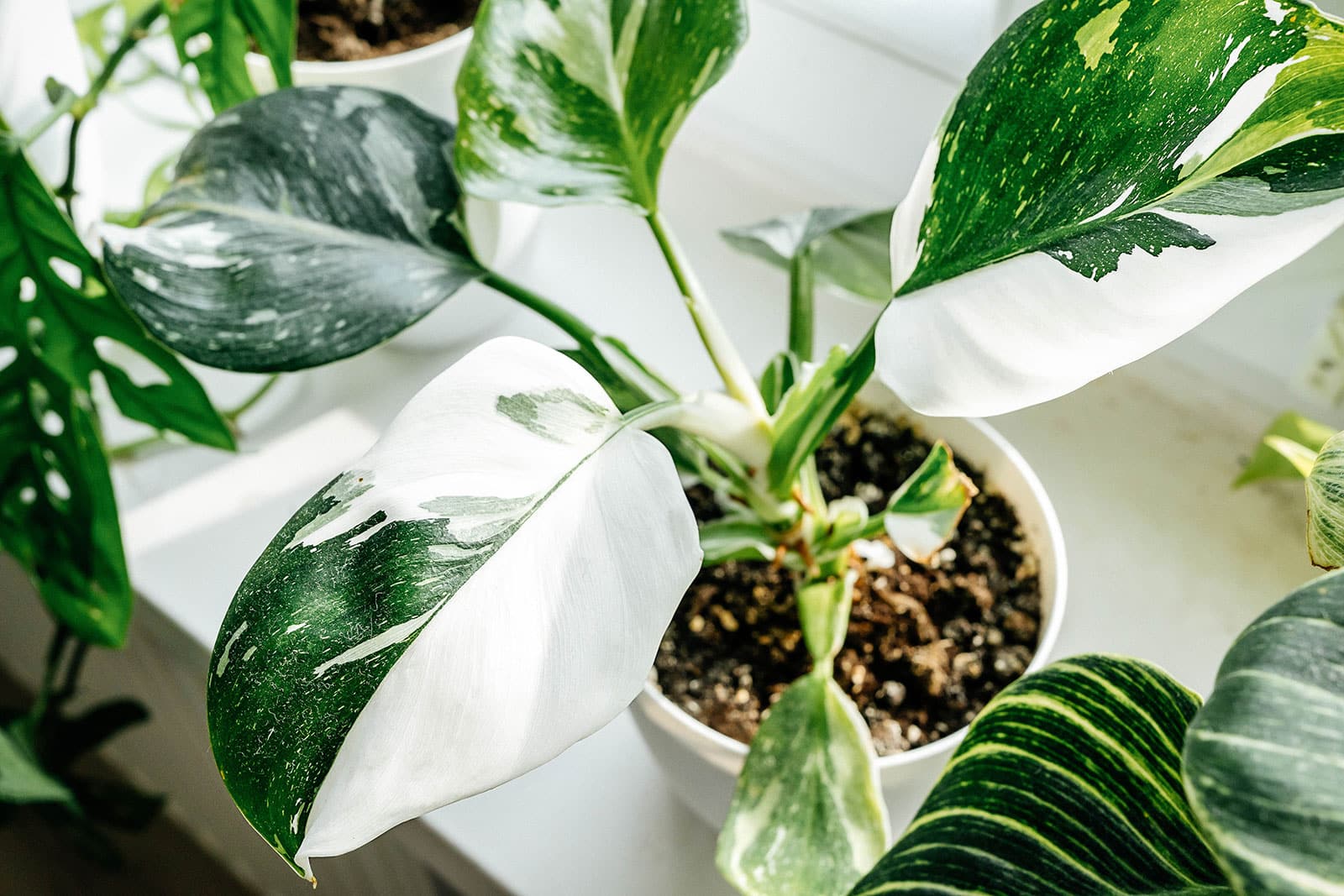
Yep, there’s also a Philodendron ‘White Princess’! It has brighter green foliage than its cousin, and rather than hot pink, its variegation usually consists of a mix of bright white and silvery splashes.
This being said, I’ve also seen ‘Tricolor’ varieties that feature small amounts of pale pink in addition to white.
As with ‘Pink Princess’, a patent was never filed for ‘White Princess’. Various guesses have been made as to its origins, but whatever the case, I’m just glad it exists!
Did you know? If you love ‘White Princess’ but can’t find it (or just want to collect all the white-variegated Philos), don’t forget to also check out the highly popular Philodendron ‘White Knight’ and Philodendron ‘White Wizard’.
Philodendron ‘Strawberry Shake’
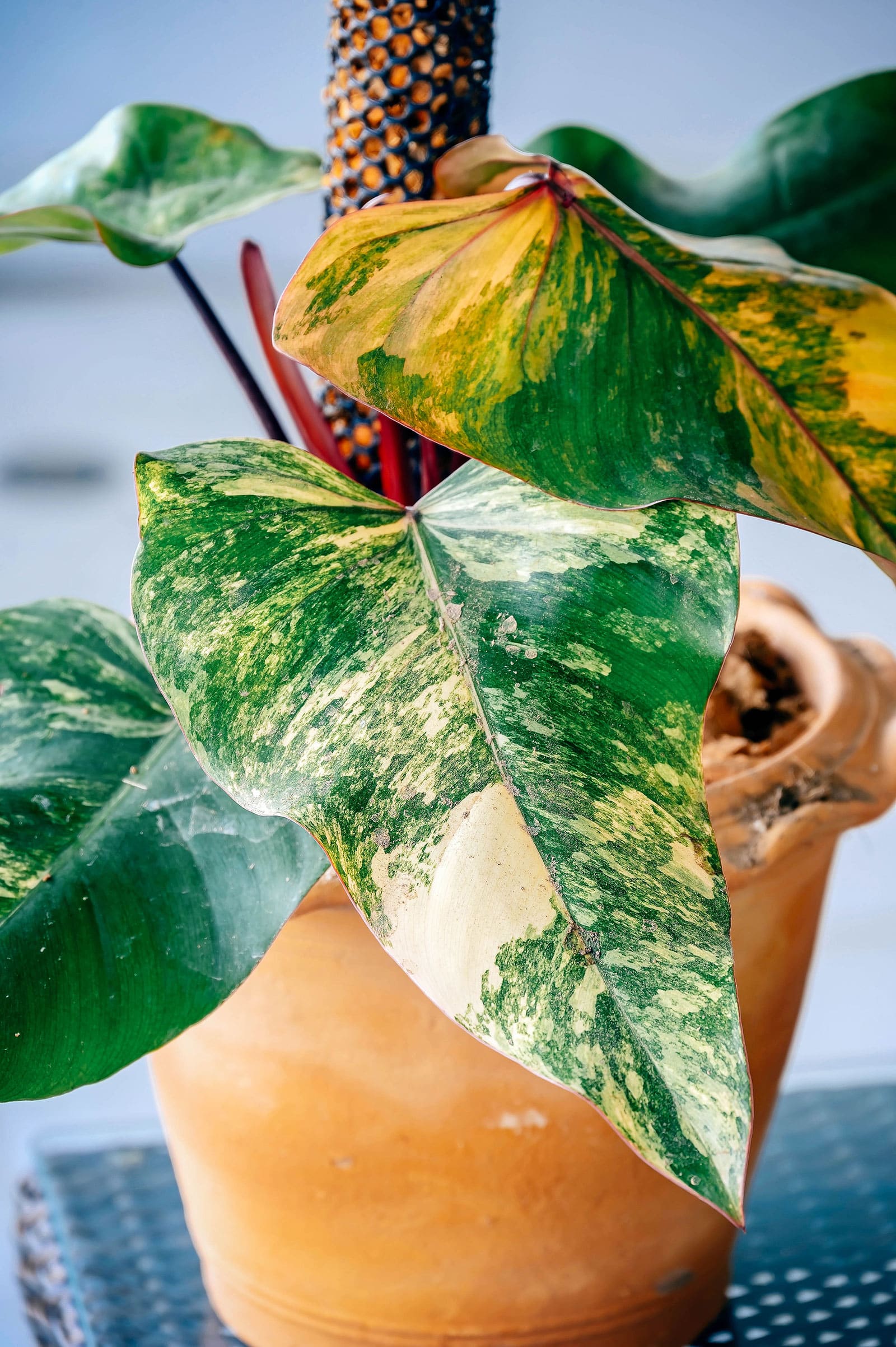
Like the aforementioned ‘Pink Princess’, Philodendron ‘Strawberry Shake’ is unpatented but generally thought to be the result of a spontaneous mutation in Philodendron erubescens. It actually looks similar to its pink cousin as well, although it’s not quite as popular or easy to find in plant stores.
Rather than the bright pink of ‘Pink Princess’, P. ‘Strawberry Shake’ is characterized by more mottled, yellowish pink variegation. Its stems are pink and its leaves tend to be slightly heart-shaped. I see potential here—if it ever becomes the new ‘it’ plant, I called it first!
Heartleaf Philodendron (Philodendron hederaceum/P. scandens/P. cordatum) cultivars
Another very popular species for the creation of new cultivars is the heartleaf Philo, P. hederaceum.
Naming for this plant is a little complicated due to growers’ tendency to slap all sorts of non-scientific denominations on a plant if they think it’ll help them sell it, which is why you’ll also see it sold as P. scandens or P. cordatum.
The species also has three naturally occurring varieties, which add to the confusion: P. hederaceum var. oxycardium, P. hederaceum var. hederaceum, and P. hederaceum kirkbridei. The former two are common, the latter not so much.
The heartleaf Philodendron can be told apart from most of the others on this list by the fact that it has thinner stems and smaller leaves. It’s more of a trailing plant and can be grown in a hanging planter with its stems cascading downward.
If you’re not into hanging pots, you can also provide your heartleaf with a trellis or plant totem. This will allow it to climb, eventually resulting in bigger foliage the higher it gets. Or just try a hanging and a climbing one if you want two different-looking versions of the same plant!
Here are a few of the most notable Philodendron hederaceum varieties:
Philodendron ‘Brasil’
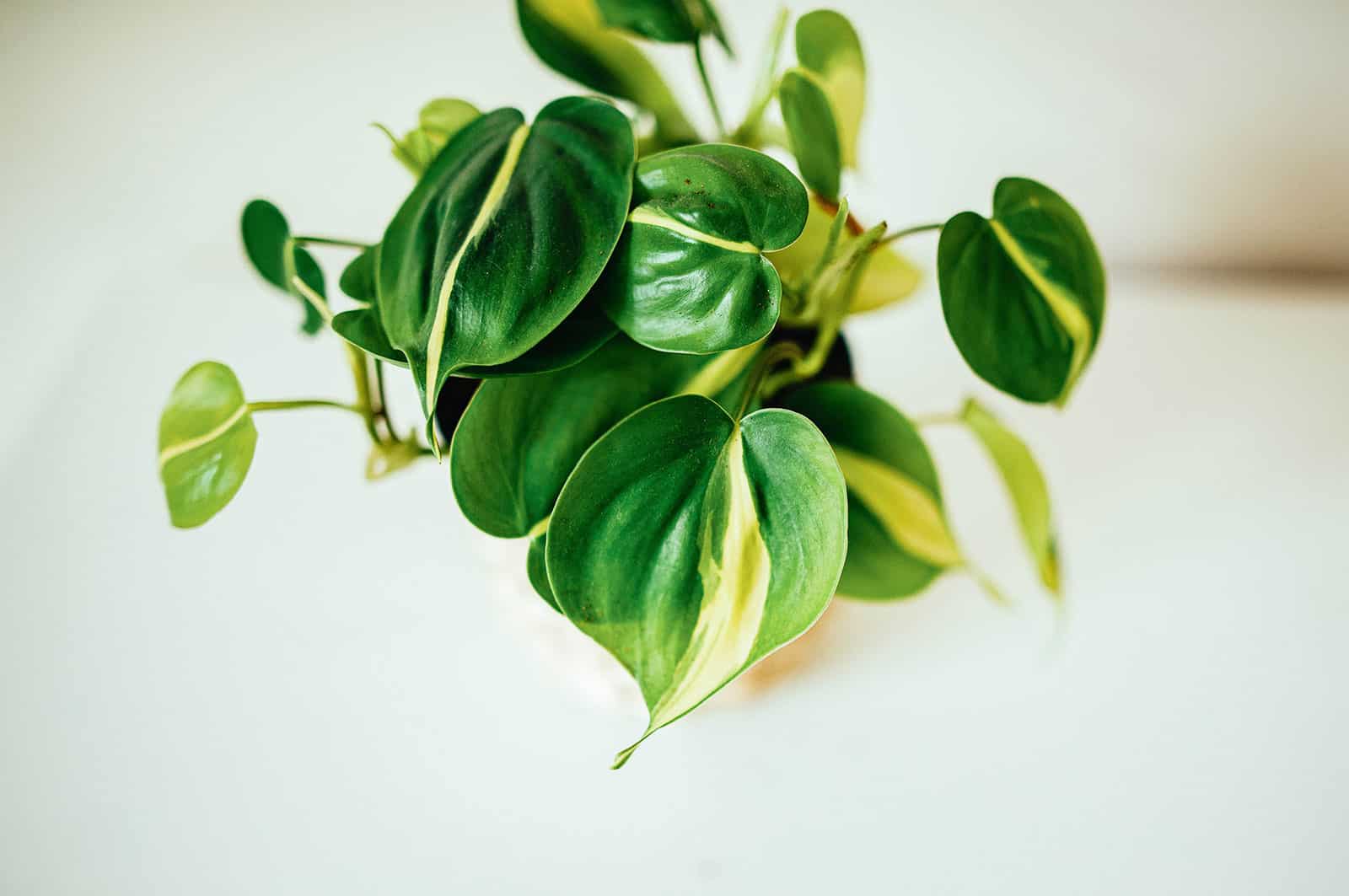
Probably the most popular of the heartleafs is Philodendron ‘Brasil’, which was discovered among a batch of Philodendron hederaceum var. oxycardium in (who could have guessed!) Brazil, in 1991.
Its striking variegated foliage, with a dark green base color and splotches of lighter green and yellow, set it apart from the others.
After being selected in Brazil, the cultivar was refined in Florida and finally patented in 2000 (expired 2020). You can still find it in any plant store today, and it’s beloved among houseplant collectors not just thanks to its pretty foliage but also its easy care and suitability for hanging planters.
Philodendron ‘Lemon Lime’
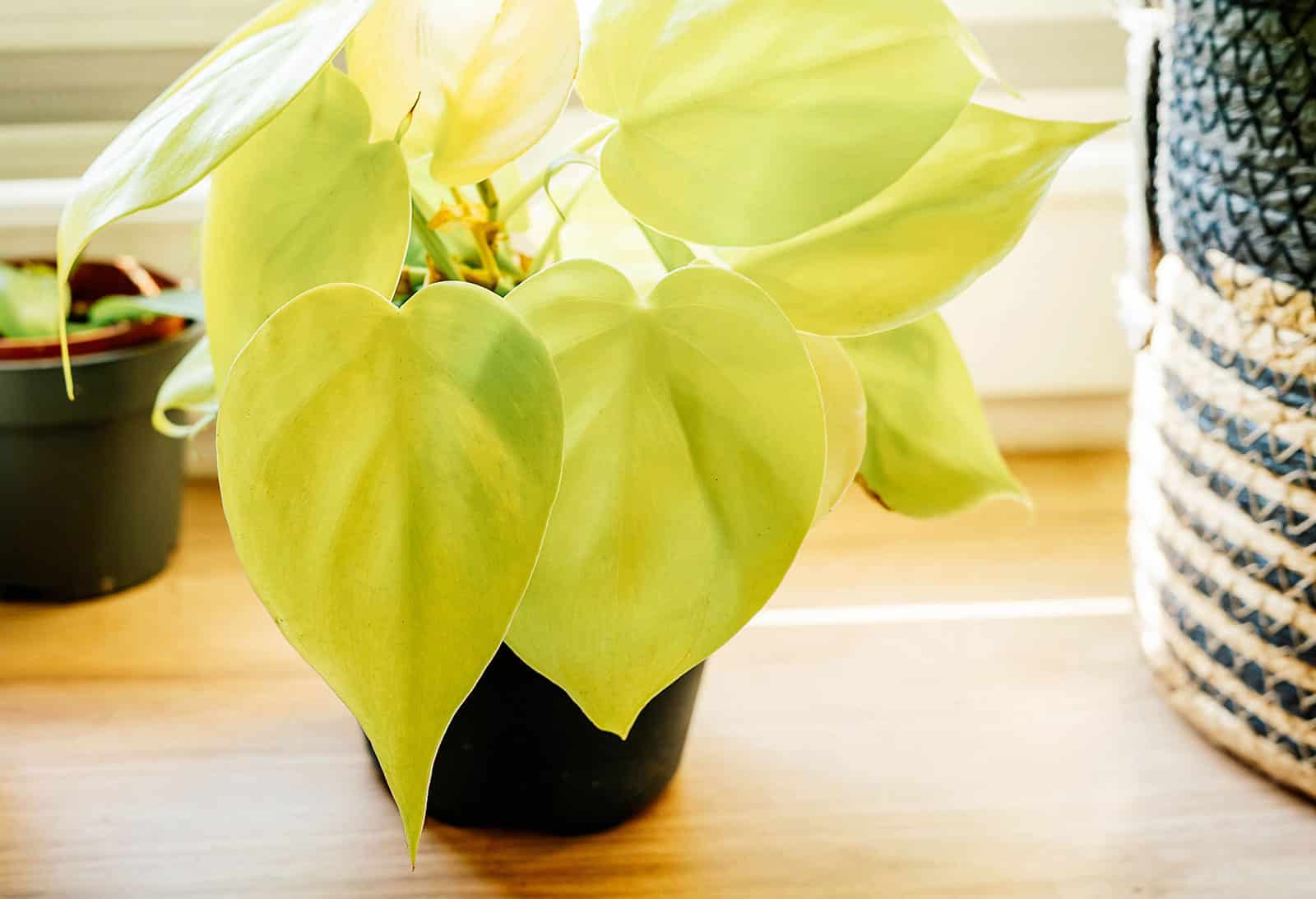
With its bright yellowish-green leaves, Philodendron ‘Lemon Lime’ almost seems to glow in the dark! I love how cheerful it looks, especially if it’s given enough light to really produce almost yellow foliage.
This Philodendron cultivar looks quite similar to a very popular Epipremnum (Pothos) cultivar called the neon Pothos. It can be told apart by its more heart-shaped leaves, as well as the fact that it has matte foliage, as opposed to the gloss on the Pothos.
Did you know? There are no restrictions on the naming of unpatented houseplants. In this case, that led to a little double trouble: There’s a different plant also called Philodendron ‘Lemon Lime’. That one’s a rosette variety, though, not a viner like our subject here. It’s apparently the result of a mutation in the hybrid Philodendron × domesticum.
Philodendron ‘Micans’ (Philodendron hederaceum var. hederaceum)

As I mentioned, there are three naturally occurring varieties of Philodendron hederaceum. The cultivars of this species we’ve discussed so far were all Philodendron hederaceum var. oxycardium, which are known for their heart-shaped, slightly glossy leaves.
The plant known as Philodendron ‘Micans’ (correct name Philodendron hederaceum var. hederaceum) is different. Its foliage is a little smaller, pointier, and most notably, delightfully velvety. They’re a brownish green in color with pretty reddish undersides. You can’t miss this classic in a Philodendron collection!
Philodendron ‘Rio’
At first glance, Philodendron ‘Rio’ can look similar to ‘Brasil’. That may be because ‘Rio’ is in fact the result of a naturally occurring mutation in ‘Brasil’!
Although I can’t find the patent, it apparently first popped up in the Gabriella Plants nursery, where it was subsequently isolated and the line stabilized.
You can tell the two “sisters” apart if you look closely: ‘Rio’ has more elongated, pointy leaves, and its variegation leans more towards cream compared to the yellow on ‘Brasil’. It’s unfortunately also a bit more difficult to find outside of the Gabriella Plants store, although I do see a few on Etsy.
Did you know? Gabriella Plants is also responsible for an additional P. hederaceum cultivar they called ‘Gabby’. The leaves on this one can be almost entirely cream-colored.
Keith Henderson’s Philodendron hybrids
Though not nearly as famous in the world of Philodendrons as the McColleys (maybe due to his works not being patented), Keith Henderson of Australia can still be called a notable hybridizer.
Although most of his hybrid Philos were produced in the 1970s and 1980s, some have recently become very popular again.
Here are a few of my favorite Henderson productions:
Philodendron ‘Ring of Fire’ (P. tortum × P. wenlandii)
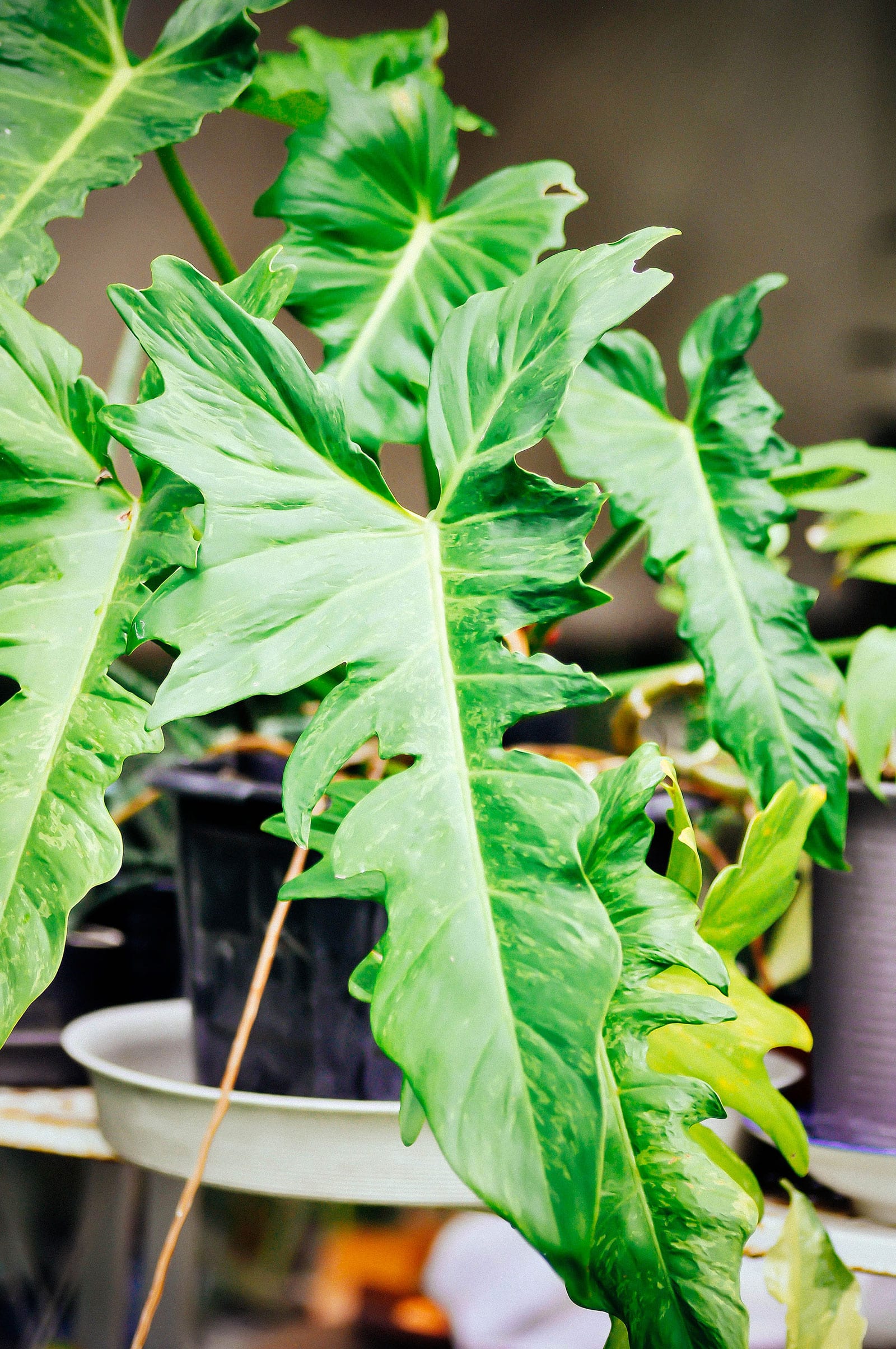
Have too much money and a love for very fancy houseplants? Let me present you to Philodendron ‘Ring of Fire’, one of those holy grail cultivars that everyone in the houseplant world covets.
There’s so much going on with this plant it’s hard to know where to start. It has large, elongated and serrated leaves covered in cream-colored splashes. New foliage comes out with a distinct orange hue on the variegated parts, and the plant can grow big quickly, making it a real head-turner.
This cultivar appears to be unpatented, but most sources state that it was originally created by Henderson, who called it Henderson’s Pride. Later, it appeared from a nursery called Asiatica, which came up with the ‘Ring of Fire’ name.
It’s assumed the plant is the result of a variegated mutation in a cross between Philodendron tortum and P. wenlandii.
Philodendron ‘Splendid’ (P. verrucosum × P. melanochrysum)

Splendid indeed! Another one of those “superstar” Philos, this cross between Philodendron verrucosum and P. melanochrysum has mom’s dramatic leaf veining and dad’s beautifully velvety foliage. The result is a climbing plant with large, heart-shaped, very dark green leaves and light green veins.
This is another unpatented variety. According to the Aroid Cultivar Registry (a handy resource for browsing Aroid plant cultivars), like ‘Ring of Fire’, it was first created by Henderson in Australia.
Although this was supposedly done in the 1980s, it didn’t pop up in the houseplant trade until much more recently, after having been named by Neil Crafter.
Philodendron ‘Glorious’ (P. gloriosum × P. melanochrysum)
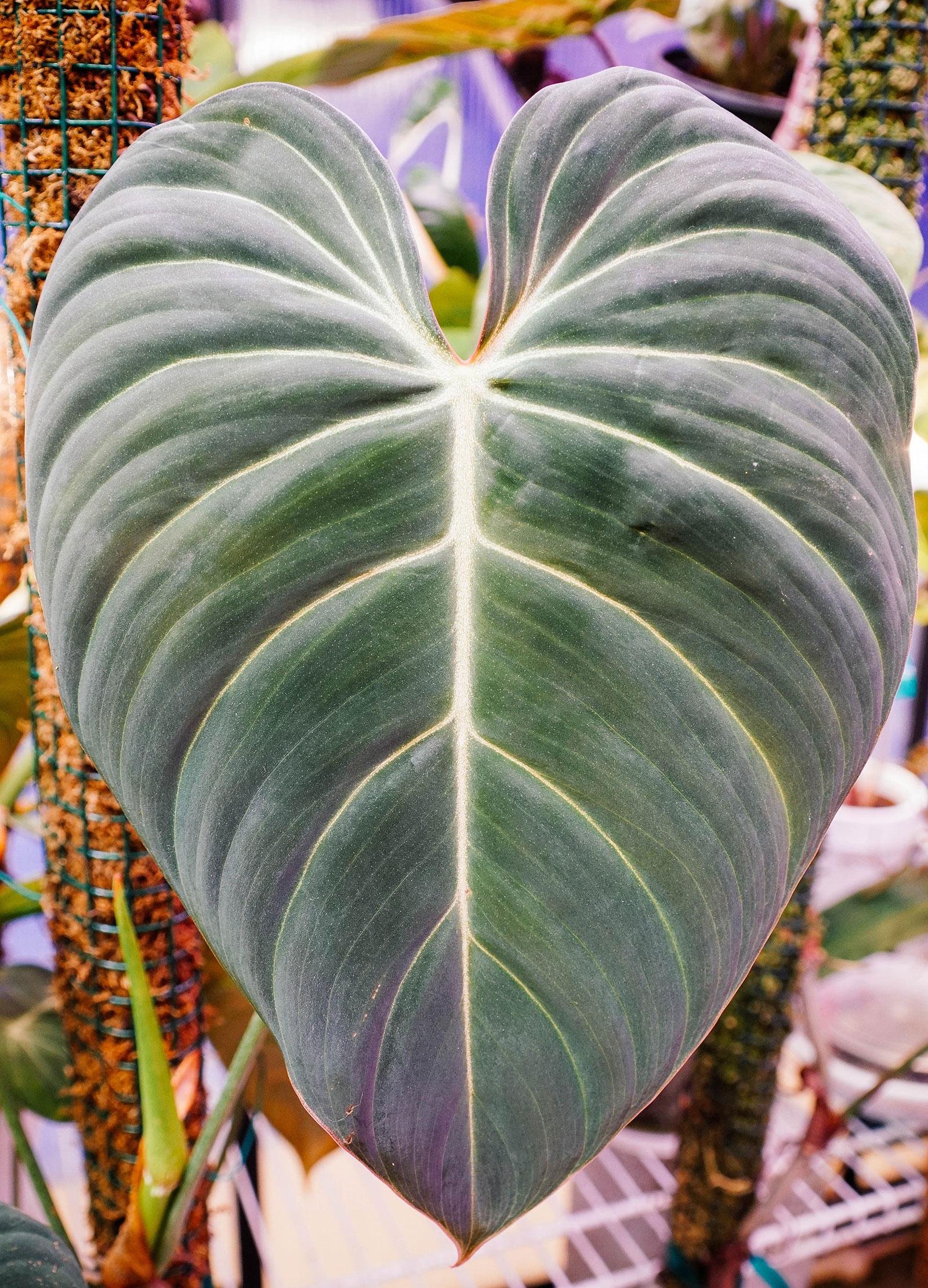
Another one of Henderson’s creations using Philodendron melanochrysum, Philodendron ‘Glorious’ (not to be confused with Philodendron gloriosum) looks relatively similar to the aforementioned ‘Splendid’.
It also has perfectly heart-shaped, velvety foliage. It’s a little more compact than its sister plant, though, and it sports more subtle leaf veining.
Created in the 1970s, Philodendron ‘Glorious’ never appears to have been patented. It has been noted that it’s unsure which was the female and which the male parent, although ‘Glorious’ definitely looks more like P. gloriosium than P. melanochrysum.
Did you know? Henderson also created the relatively well-known Philodendron ‘Majestic’.
More Philodendron varieties
Silver sword Philodendron (Philodendron hastatum ‘Silver Sword’)

How gorgeous is this one?!
I can’t seem to figure out if P. ‘Silver Sword’ is actually a man-made cultivar, or if it’s just a fancy name that growers slapped on wild-type Philodendron hastatum plants in order to make them easier to sell. But, I’m willing to overlook this confusion in favor of its spectacular foliage.
As its name suggests, Philodendron ‘Silver Sword’ is a very light, greyish green in color. The natural sheen on its elongated leaves makes it look almost silvery. Although its stems aren’t as thin as those on something like a heartleaf Philo, it’s definitely a vining variety, so attach yours to a plant totem or trellis to see it in its full glory.
‘Silver Sword’ used to be rather rare and expensive, but luckily, it’s slowly becoming easier to find and more affordable.
Philodendron ‘Imperial Red’
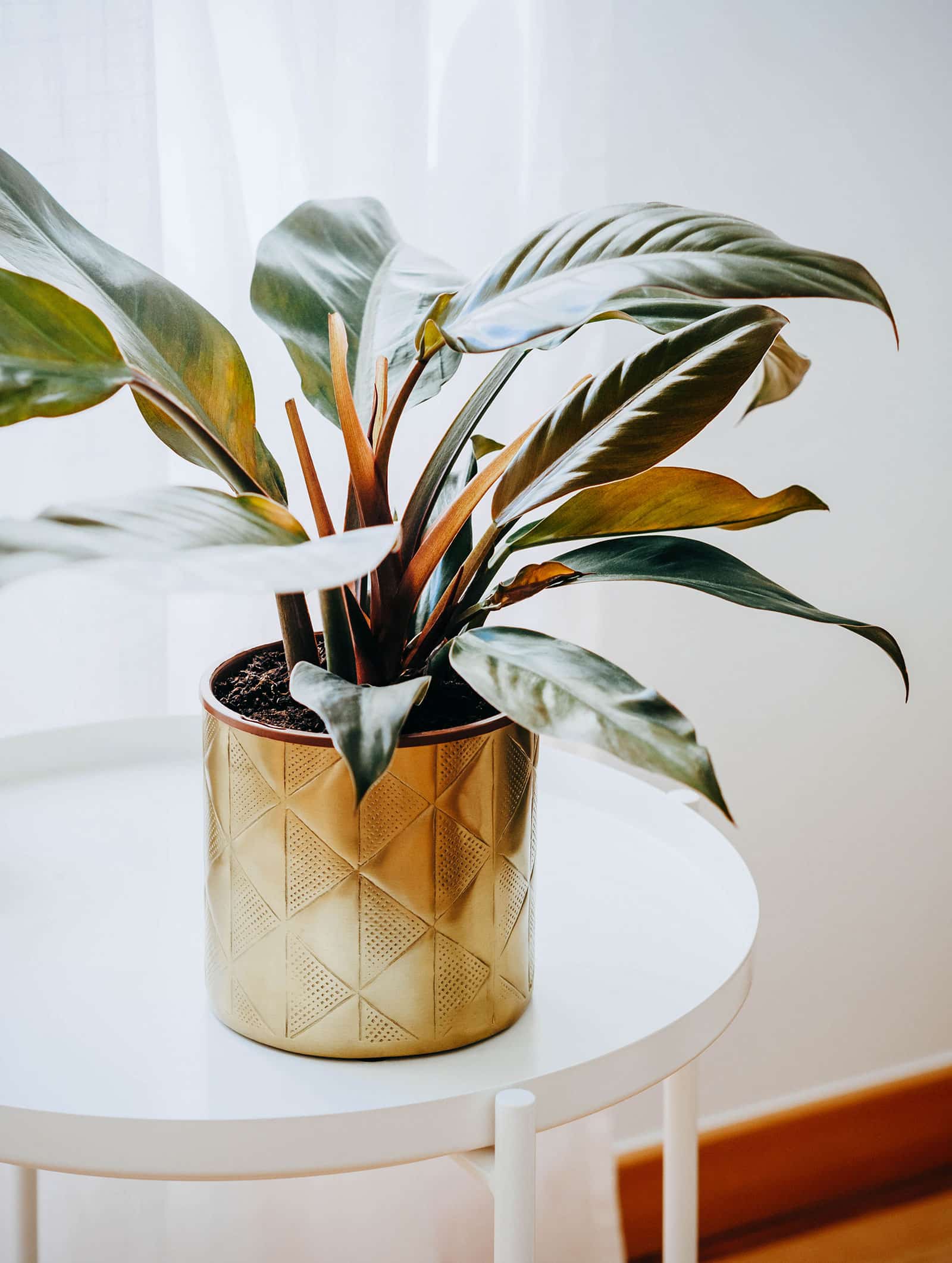
Although Philodendron ‘Imperial Red’ was produced in Belgium (patented 1986), we have to give a little shout-out to the McColleys here: The seedlings from which it was produced were acquired from their nursery.
‘Imperial Red’ is appreciated for its striking dark leaves, which emerge with a distinct maroon hue and then shift to green as they mature. The foliage is quite large, leathery and shiny.
Variegated cultivars with lighter red splotching also exist, although they don’t appear to be very common.
Did you know? There’s also a Philodendron ‘Imperial Green’, produced by the same Belgian nursery.
Philodendron ‘Rojo Congo’

Known for having a more upright growth pattern than many of the aforementioned Philodendron cultivars, ‘Rojo Congo’ is a child of ‘Imperial Red’ (crossed with Philodendron tatei spp. melanochlorum).
Don’t confuse this one with the fully green Philodendron ‘Congo’! You can tell ‘Rojo Congo’, which was patented in 2001 by yet another Floridian nursery, apart by looking at its stems and immature leaves.
As the name suggests, these are reddish in color. This particularly applies to the leaf undersides.
Philodendron ‘Birkin’
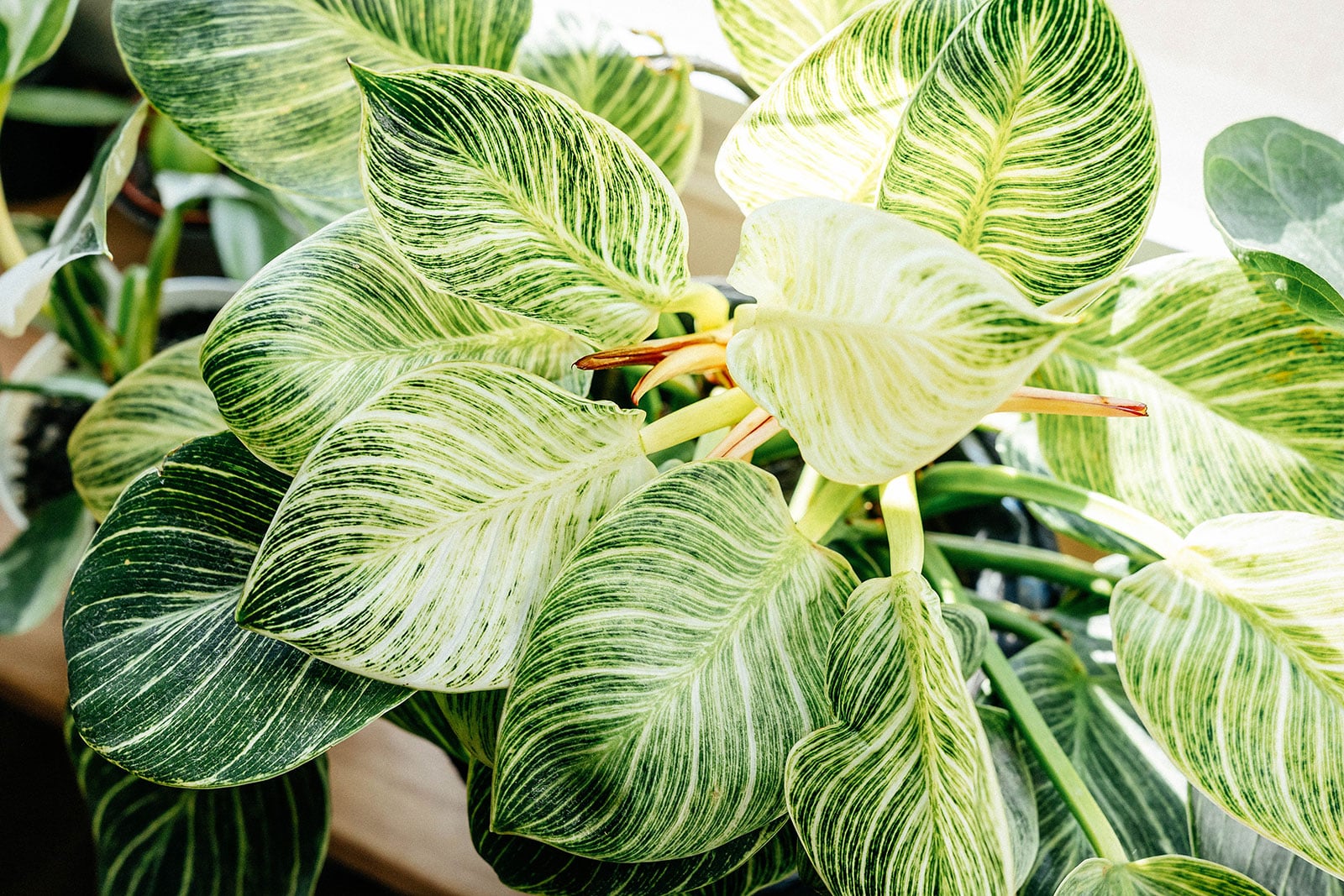
Another one of those Philodendron varieties that has recently experienced a huge burst of popularity is Philodendron ‘Birkin’ (occasionally known as P. ‘White Wave’).
Unpatented but seemingly the result of a spontaneous mutation in P. ‘Rojo Congo’, its stripey leaves make it one of the most striking cultivars on the list.
In my experience, the leaves on Philodendron ‘Birkin’ tend to stay on the smaller side. It’s another self-heading Philo, meaning that it normally doesn’t grow much of a stem either. All this makes it a great choice if you’re looking for a more compact Philodendron variety!
You can learn more about it in my Philodendron ‘Birkin’ plant care guide.
Philodendron ‘Jungle Boogie’ (P. pinnatifidum × P. melinonii)
If you liked the foliage on Keith Henderson’s P. ‘Ring of Fire’, you may like this one as well: Philodendron ‘Jungle Boogie’.
Although it lacks the spectacular variegation, it’s still a really cool-looking plant, with similarly large, long and serrated leaves. The leaves do come out a pretty orange color before they harden off into green.
I’ve found conflicting information about the origins of ‘Jungle Boogie’. Although some sources say it’s patented, I can’t find patent information anywhere. It’s supposedly a cross between Philodendron pinnatifidum and melinonii, but take that with a grain of salt.
If you’re looking for a Philodendron ‘Jungle Boogie’, keep in mind that it might also be called ‘Tiger Tooth’. There’s also another very similar cultivar called P. ‘Narrow Escape’.
Philodendron ‘Summer Glory’ (P. gloriosum × Unknown)

If you liked Philodendron varieties like ‘Glorious’ and ‘Splendid’ but want something with smooth rather than velvety leaves, here it is!
Philodendron ‘Summer Glory’ has similar heart-shaped foliage and prominent leaf veins, but it’s beautifully glossy rather than matte. New leaves come out a dark reddish green.
This is a recent addition to the arsenal of Philodendron varieties. The patent was filed in 2021, meaning it’s still in vigor and won’t expire until 2041.
The cultivar was developed in Florida by LariAnn Garner, who is known for extensive hybridization work with different Aroids. It’s the result of a cross between P. gloriosum and an unnamed Philodendron hybrid from the McColley nursery.
Honorable mentions
Remember at the start of this post when I said that Philodendron naming is a total doozy? Well, it doesn’t help that horticulturalists are always moving plants in and out of different genera.
A plant is moved when it turns out that it’s actually more closely related to members of a different genus. This can cause confusion, as not everyone tends to get the memo, meaning they’re sometimes referred to by their old name and sometimes by the new one.
Most notably, a good bunch of popular houseplants that previously belonged to the genus Philodendron were moved to a previously existing but unused genus called Thaumatophyllum in 2018.
This included some long-time favorites like:
- Philodendron xanadu (now Thaumatophyllum xanadu)
- Philodendron selloum, also sometimes Philodendron ‘Hope’ (now Thaumatophyllum bipinnatifidum)
- Philodendron goeldii (now Thaumatophyllum spruceanum)
There are also a few houseplants that are popularly referred to as Philodendrons, but were actually never Philos at all. They just have similar growth patterns.
For instance:
- The ever-popular split-leaf Philodendron is actually called Monstera deliciosa.
- The houseplant sometimes known as satin Philodendron in reality belongs to the genus Scindapsus.
McColley, R. H., & Miller, H. N. (1965). Philodendron improvement through hybridization. In Proc. Fla. State Hort. Soc (Vol. 78, pp. 409-415).
View the Web Story on Philodendron varieties.


